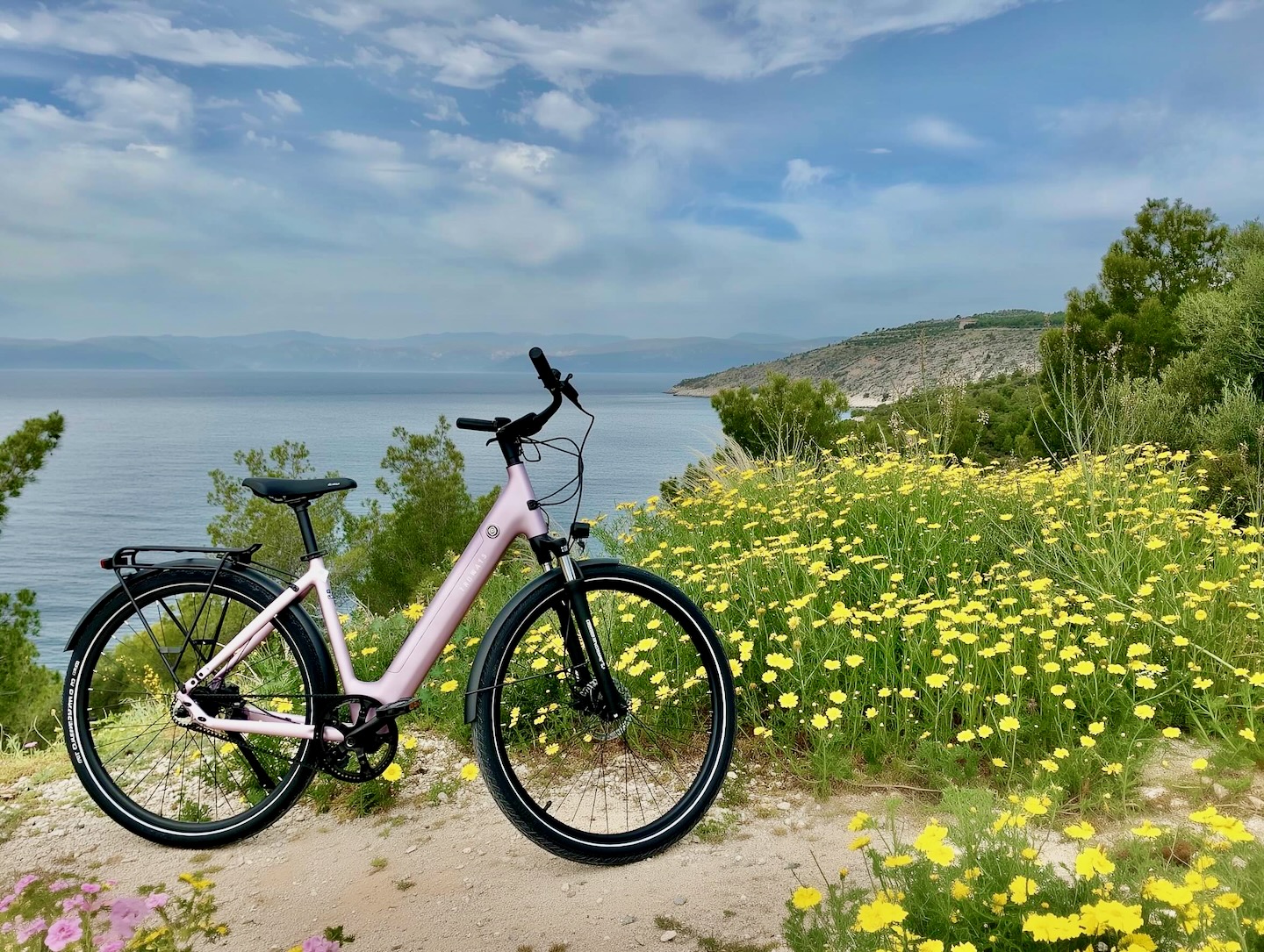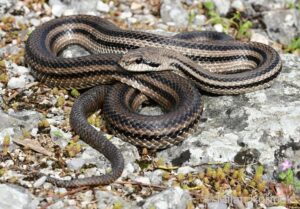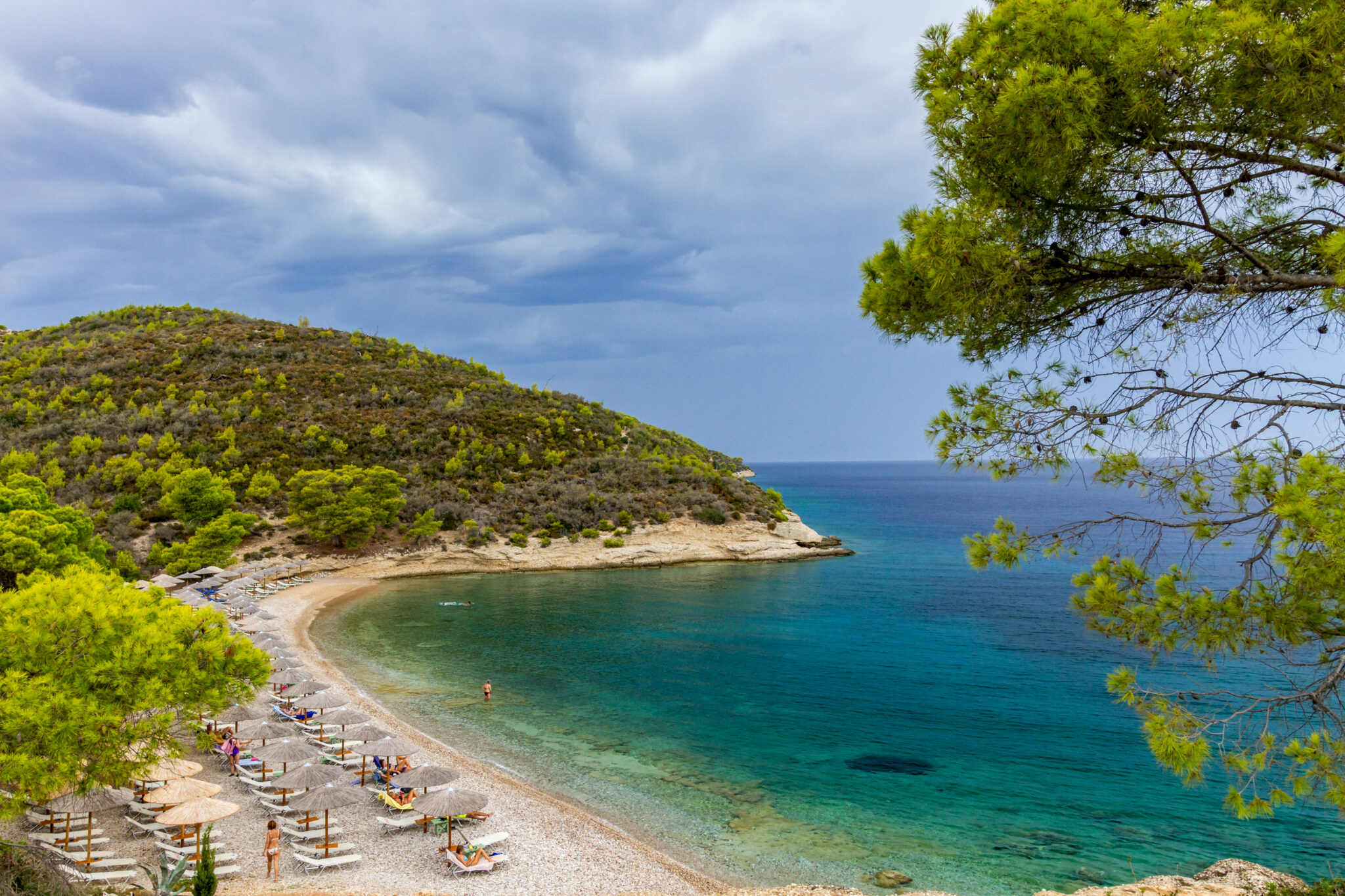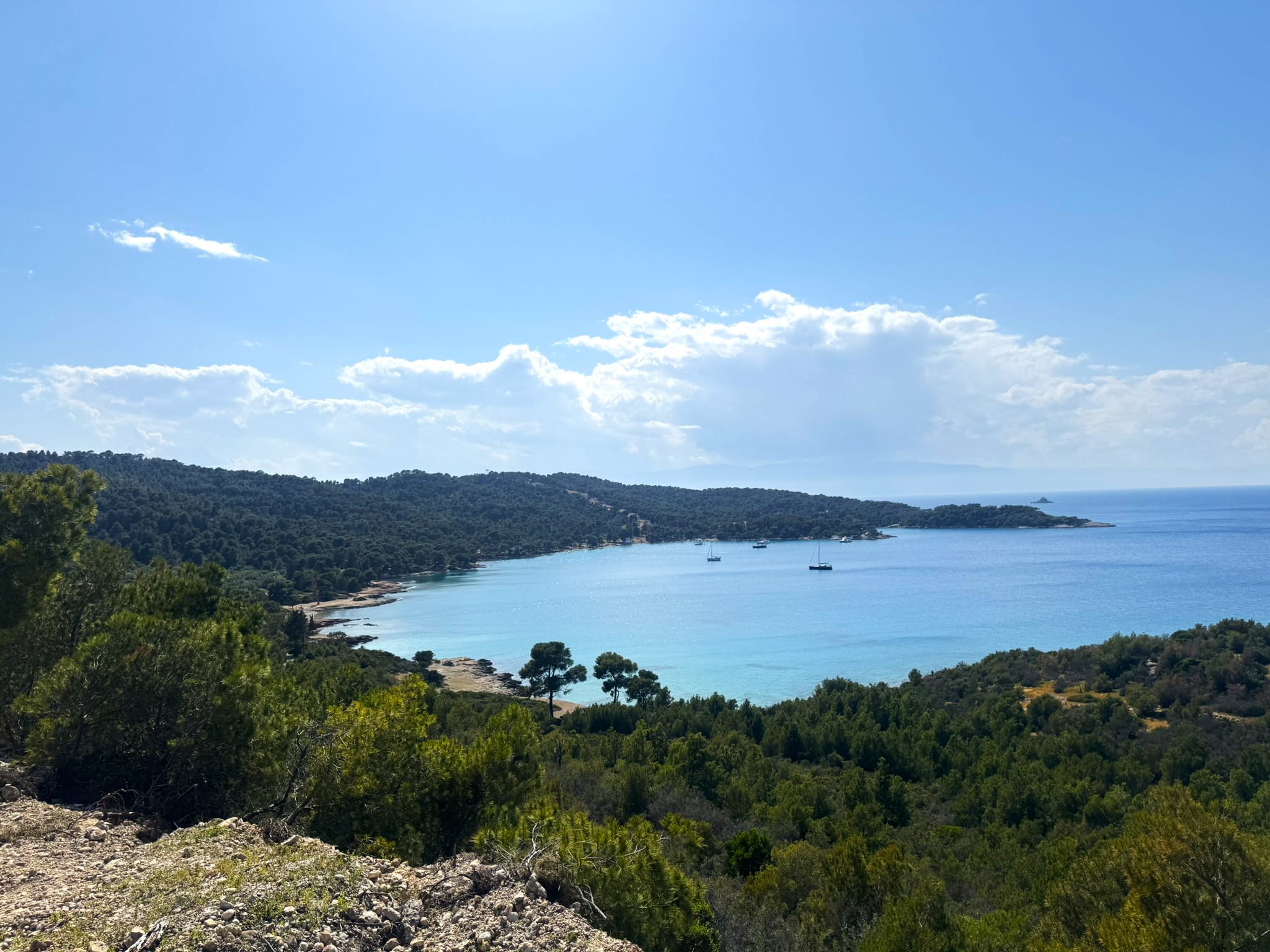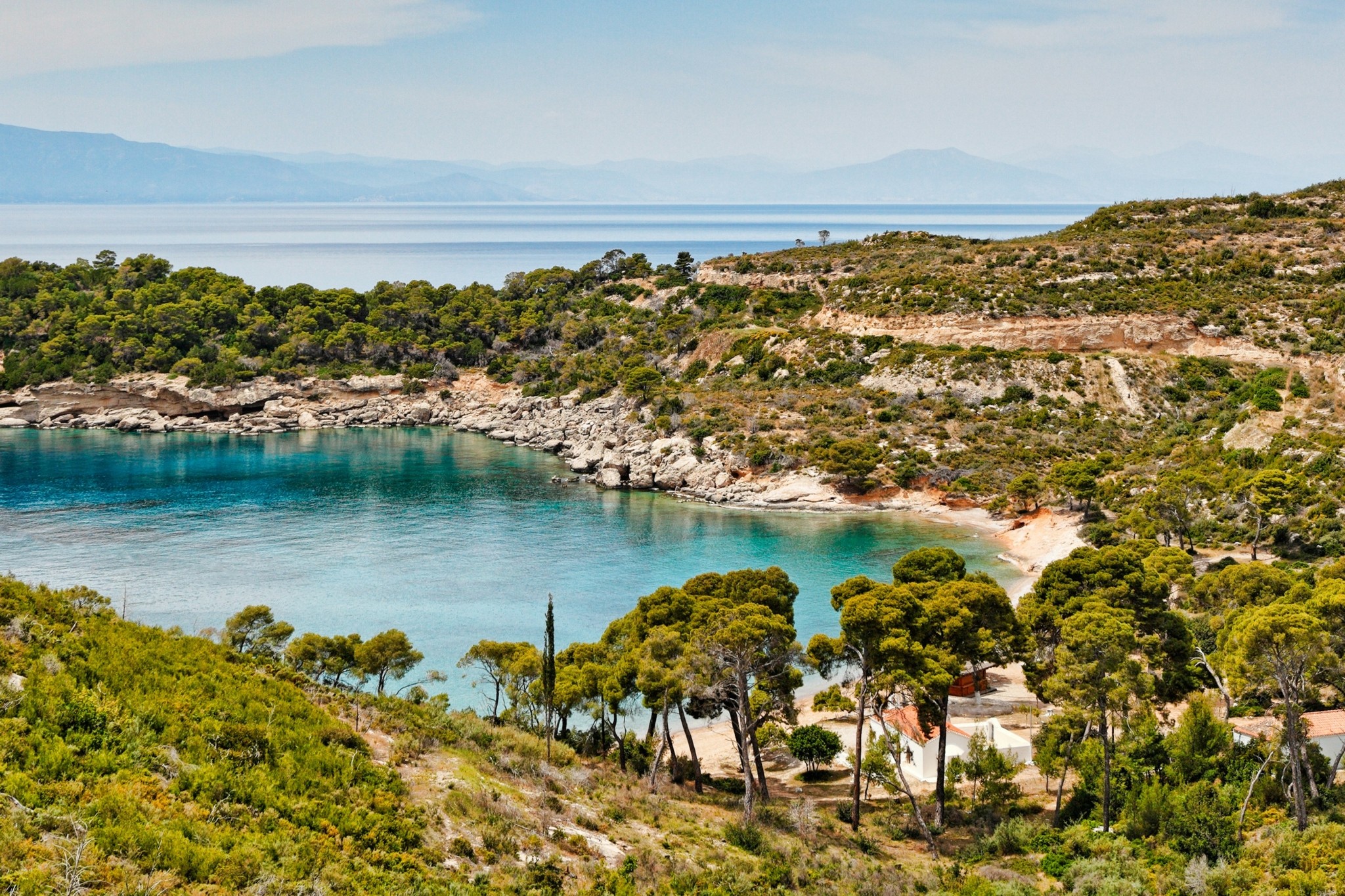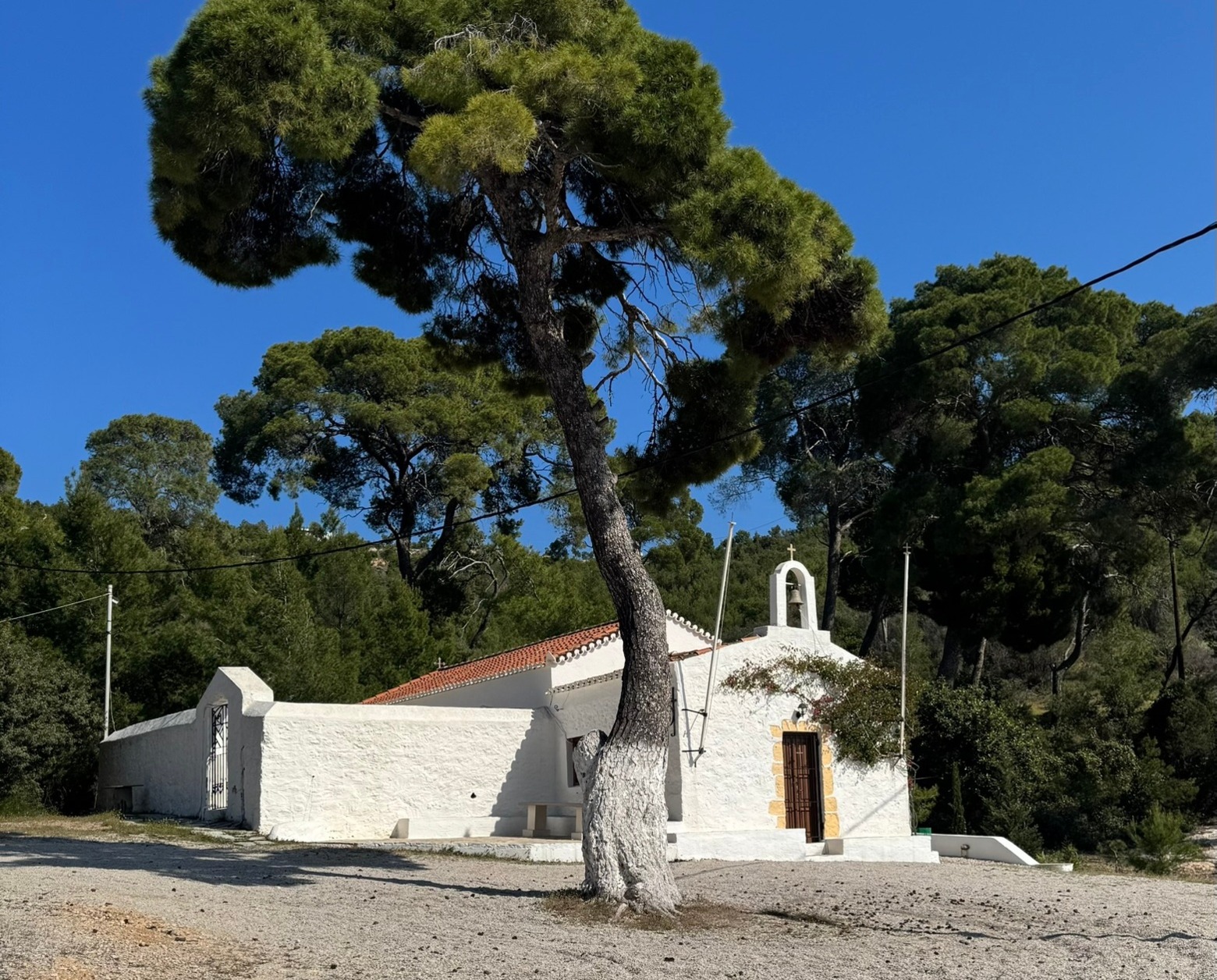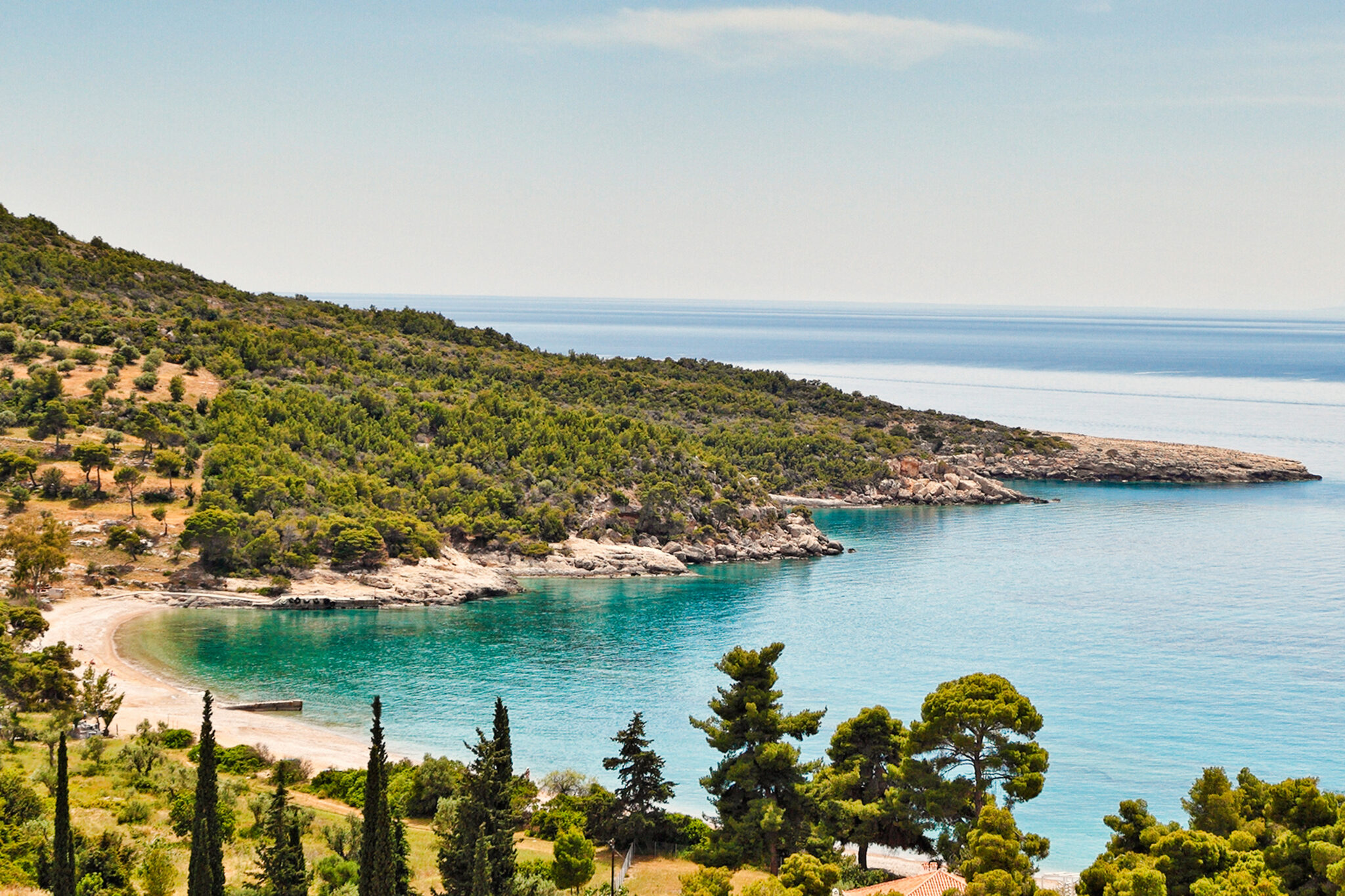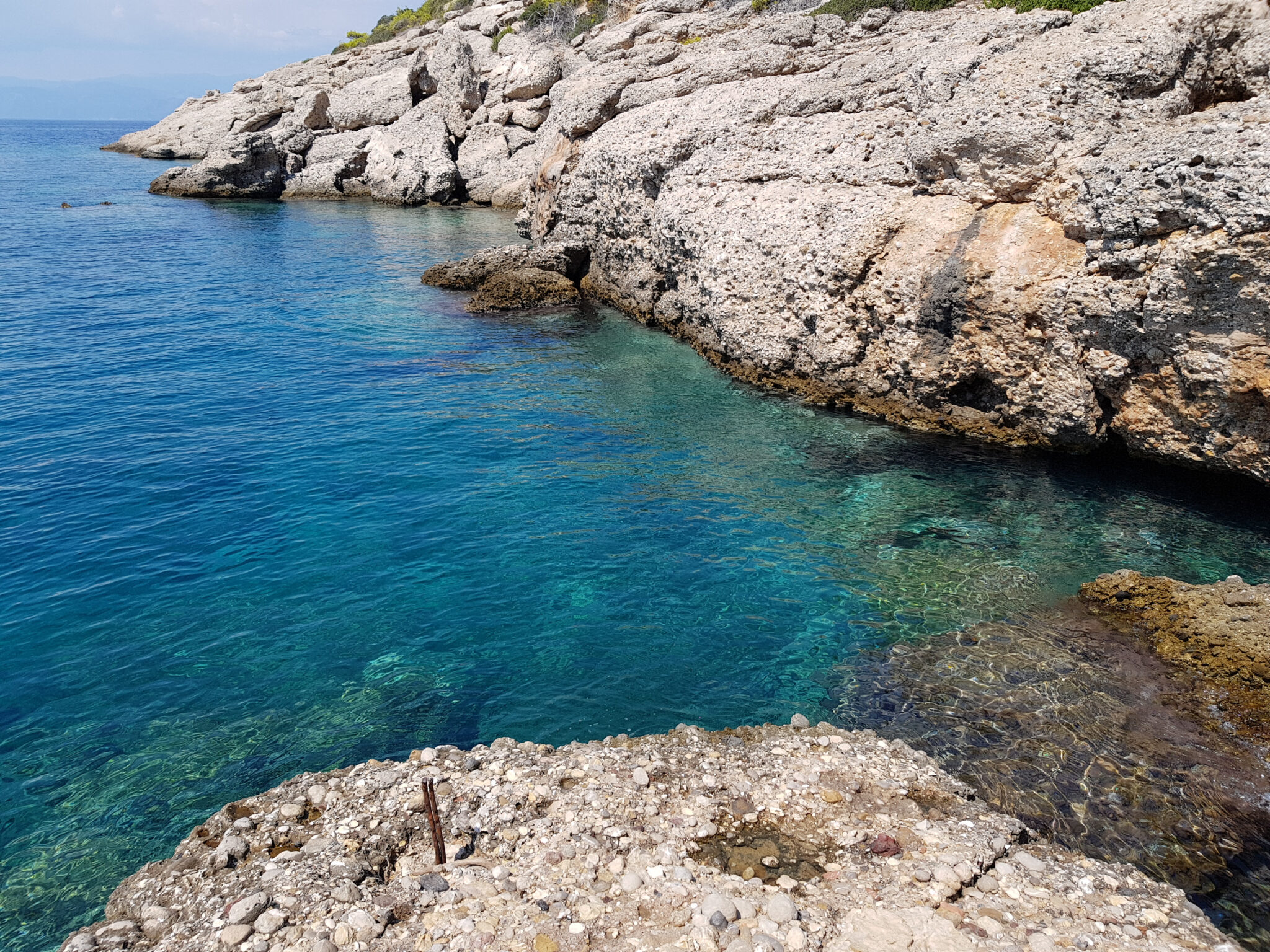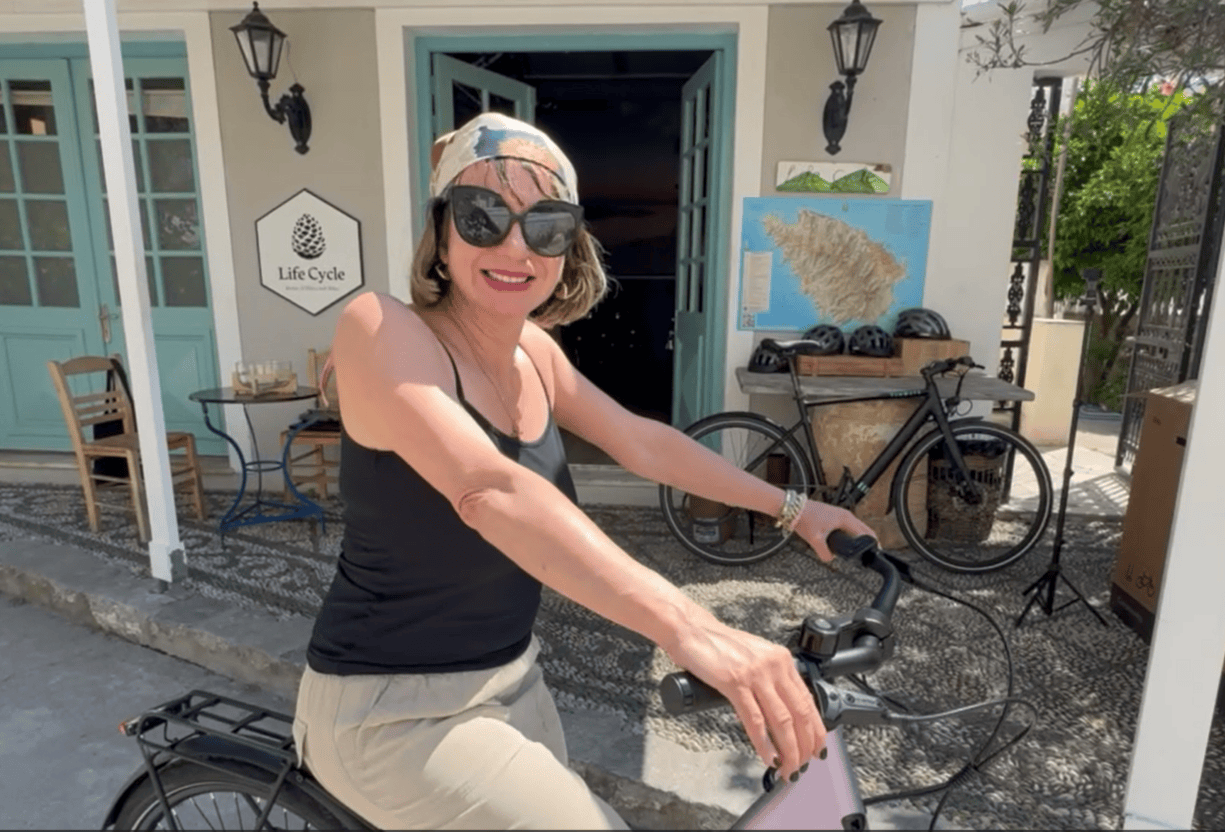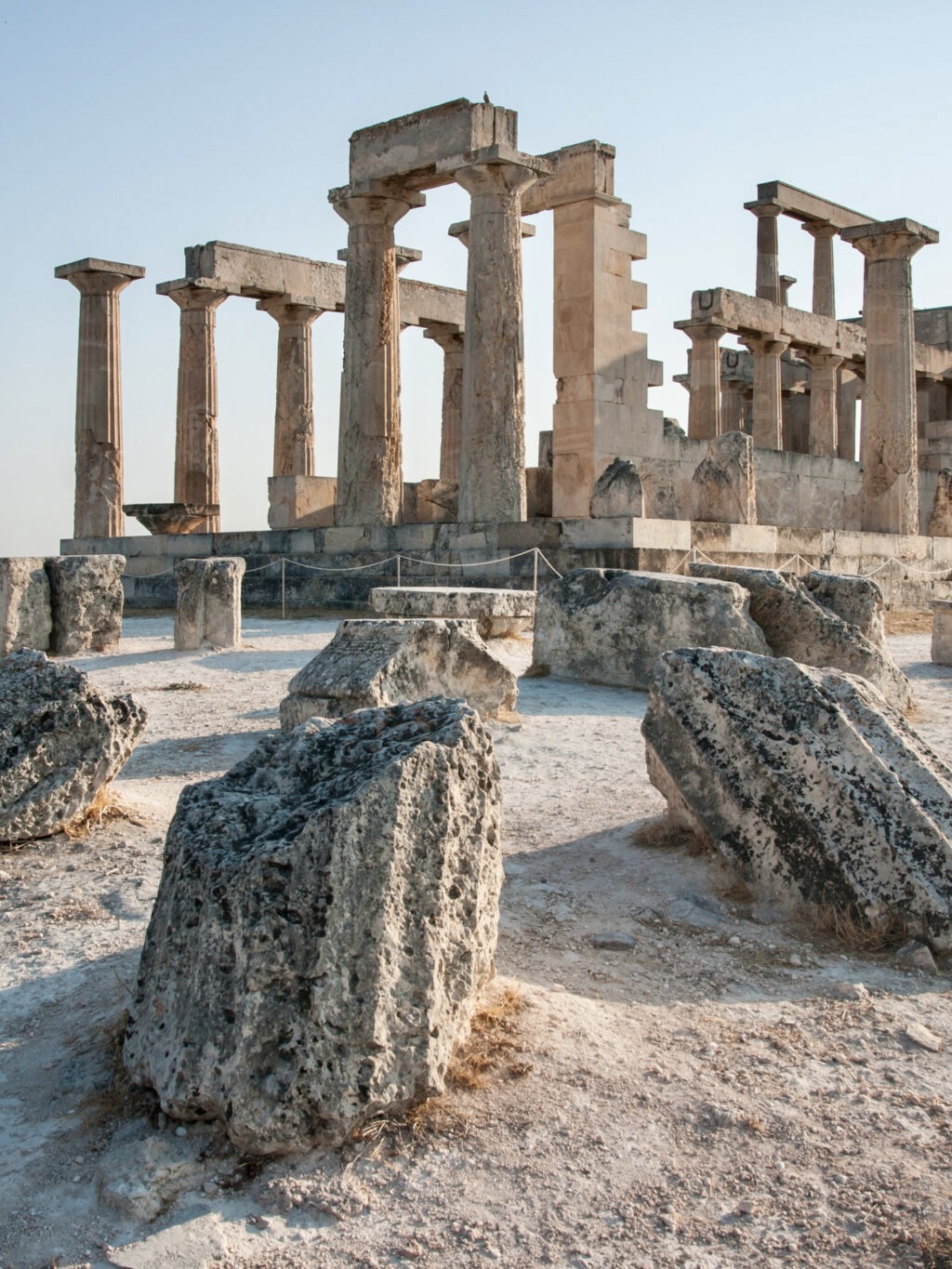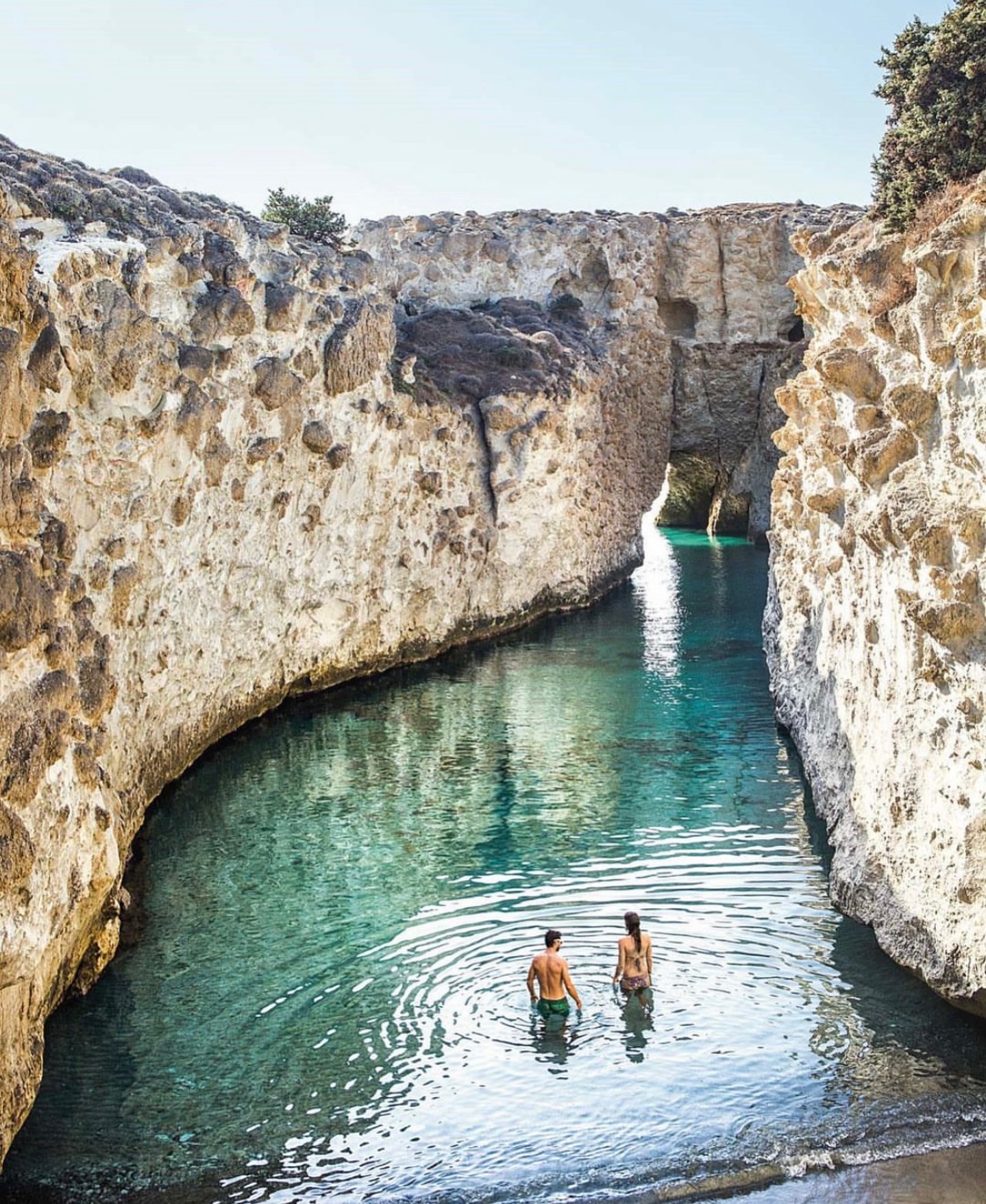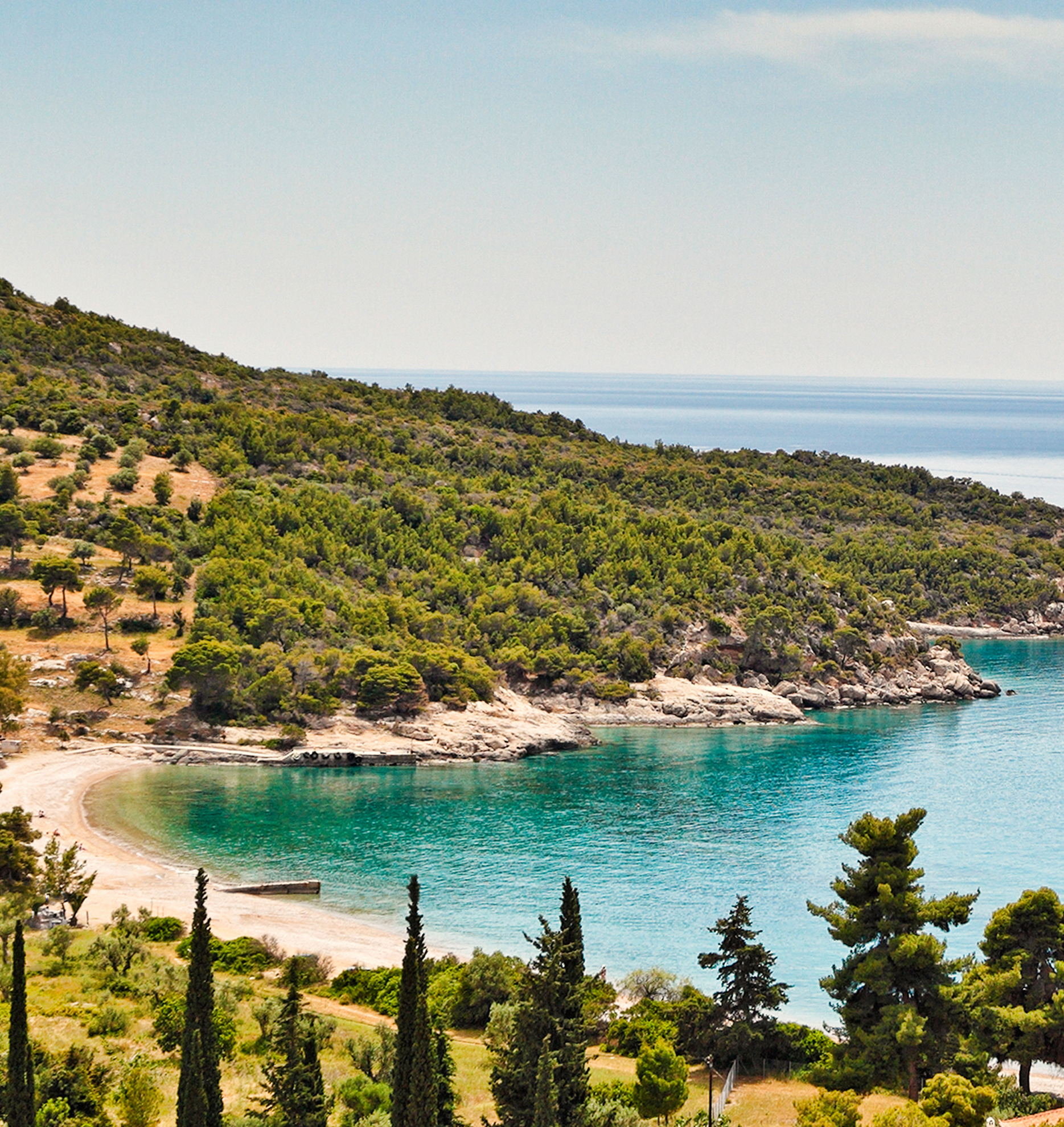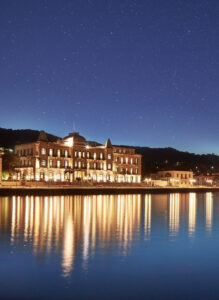Traveling solo on a weekend escape to Spetses, an Argosaronic island two hours’ boat ride from Piraeus port known for its beauty, historical significance in the Greek War of Independence, and cosmopolitan vibes, I was advised to try cycling around the island. “It’s a fantastic experience, and with an electric bike, very easy to do,” the kind concierge at the Grand Poseidon Hotel enthused.
“There are outstanding views to enjoy, and plenty of lovely beaches to stop at for a swim!” Instantly sold, I knew this would combine some of my favorite things in the world – nature, sea, cycling, and the liberating feeling of wind in my hair after months of stagnation over my laptop in Athens.
The Bicycle Whisperer
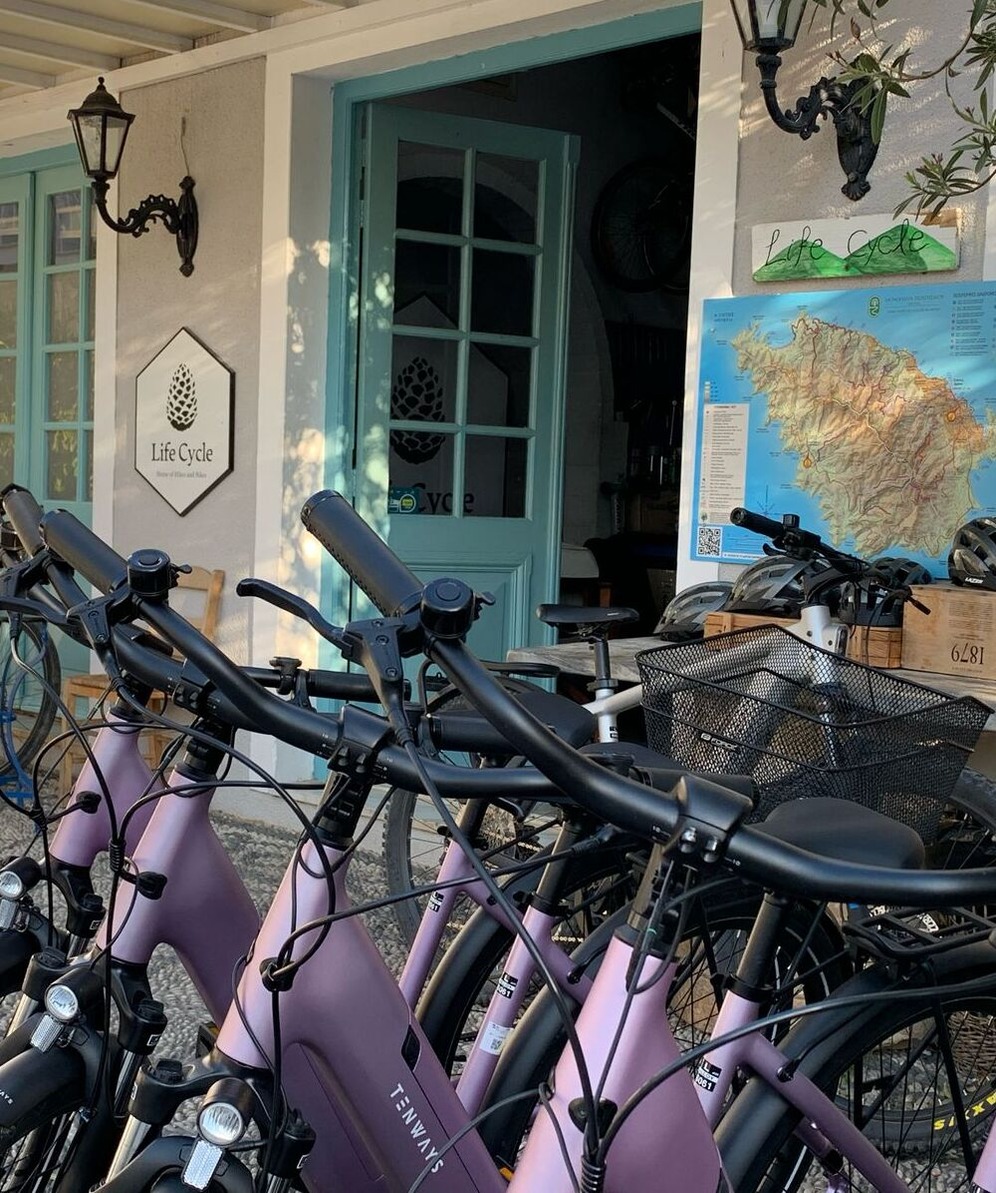
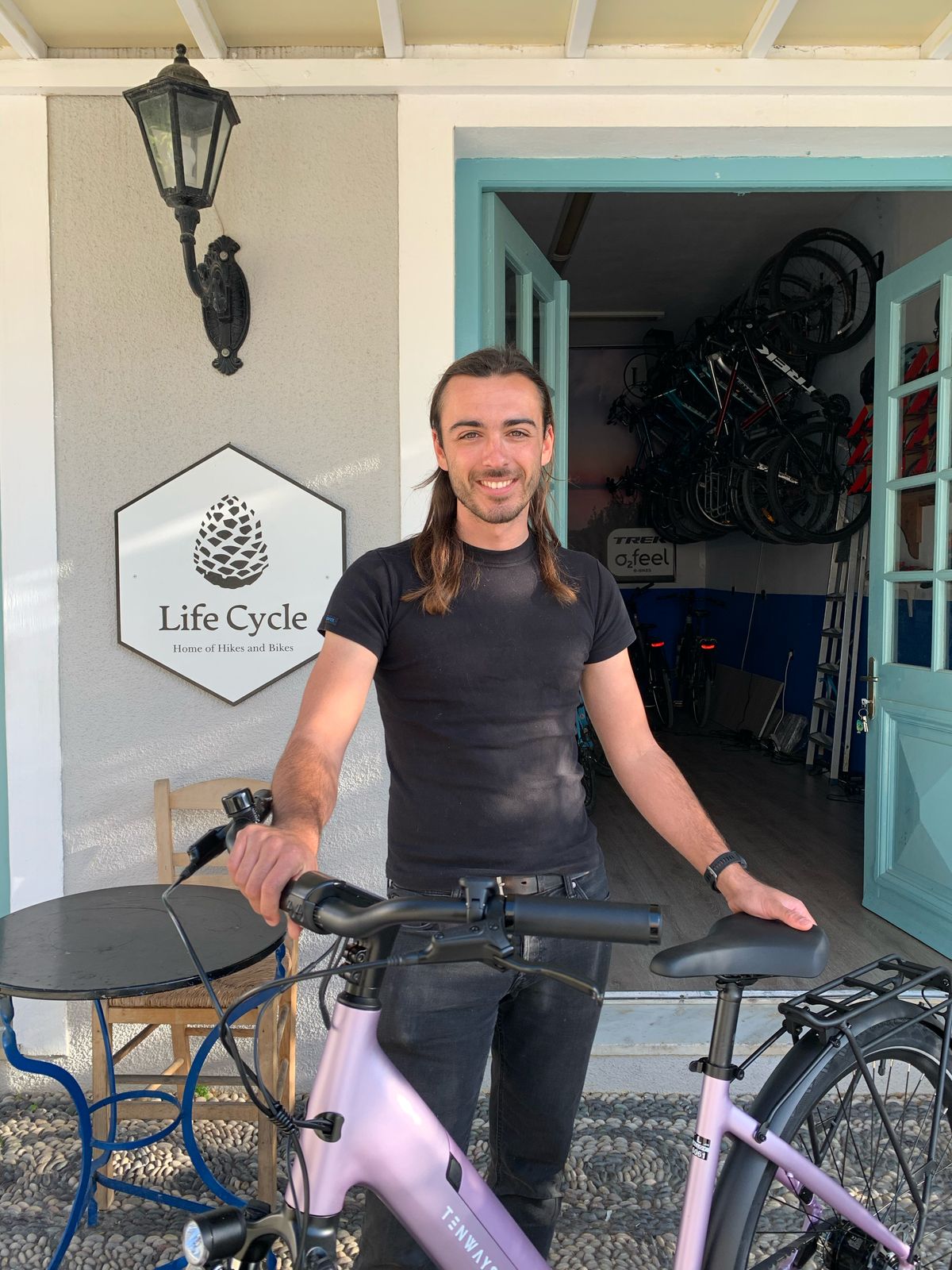
Upon reaching the bike rental place, I meet Christopher Kontaratos, the friendly and knowledgeable Greek-English owner of ‘Life Cycle, Home of Hikes and Bikes.’ Instantly, we are drawn into an interesting chat about the island. Christopher’s parents have rented bikes, motorbikes, and quads on the island since 1990, and in 2020 he launched his own business, now focused exclusively on bicycles – both regular and electric – because they’re environmentally friendly and don’t create noise pollution.
On this third visit to generally car-free Spetses (though not as strictly as neighboring Hydra, where traffic consists solely of people and donkeys), I noticed the noise level had indeed risen a notch, even in late April. I mention this to Christopher and he agrees that indeed, it used to be far quieter even a few years ago. “I doubt my choice to rent only bikes will make a difference,” he sighs, “but it’s worth a try!”
The Perfect Circuit
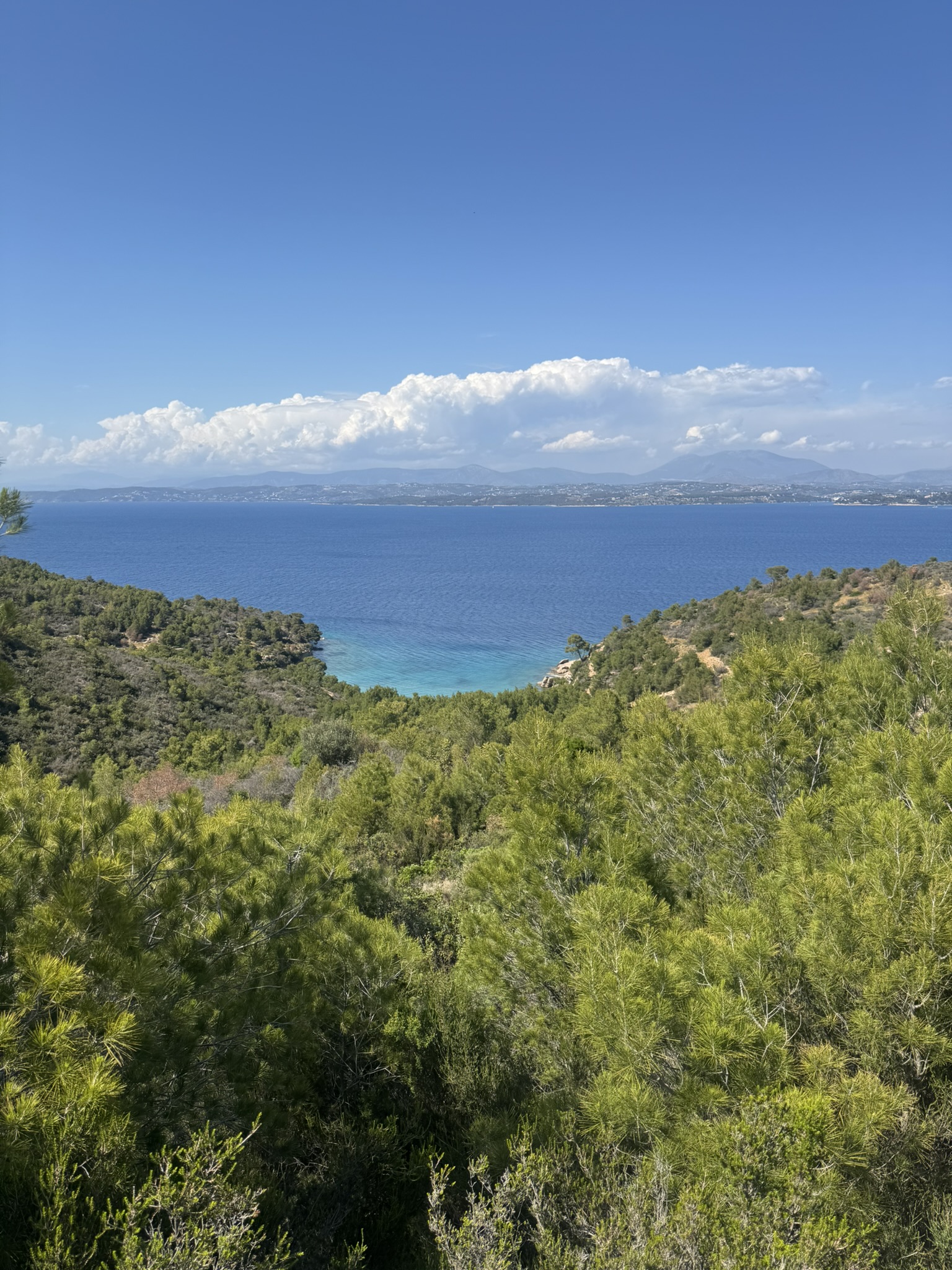
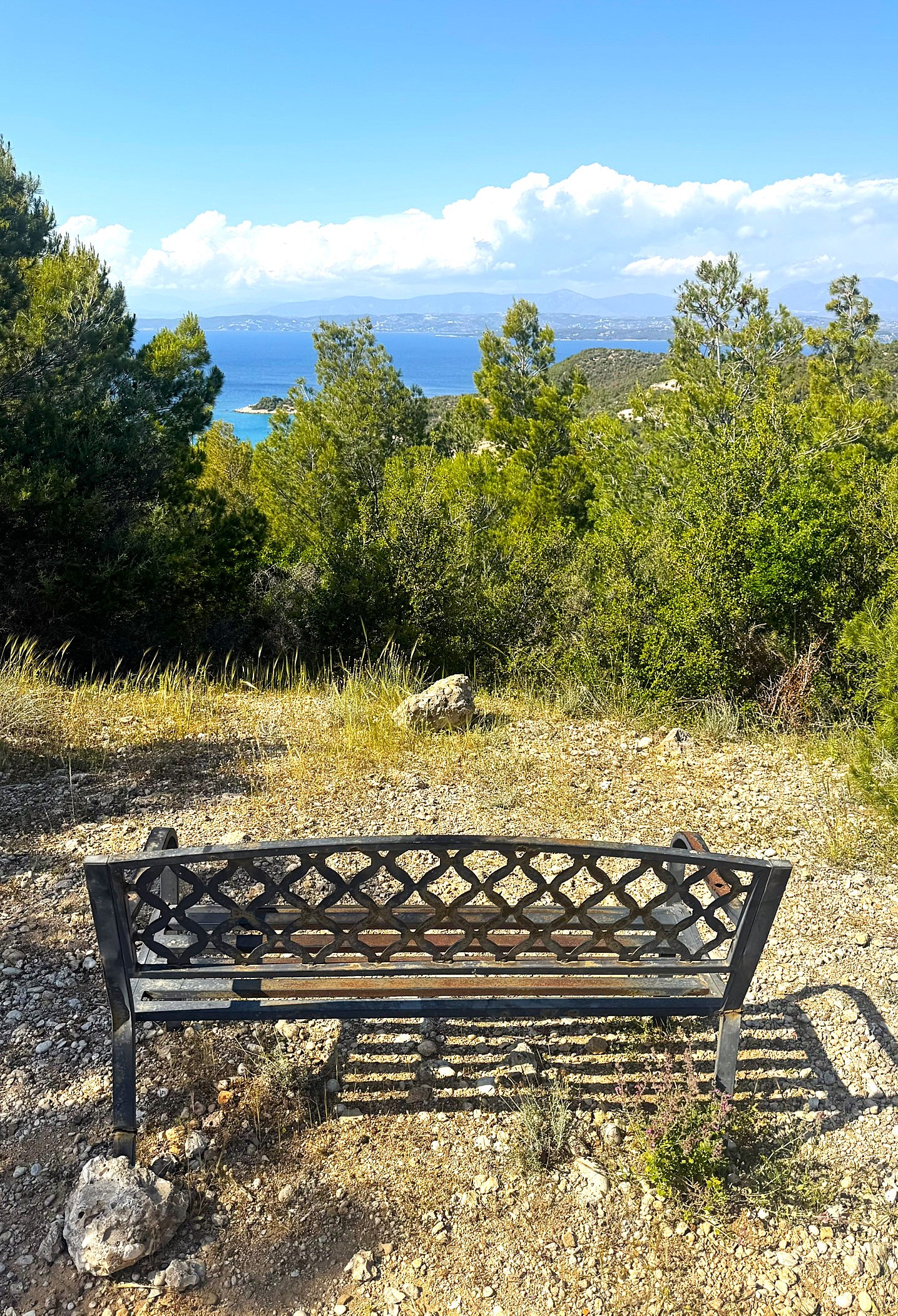
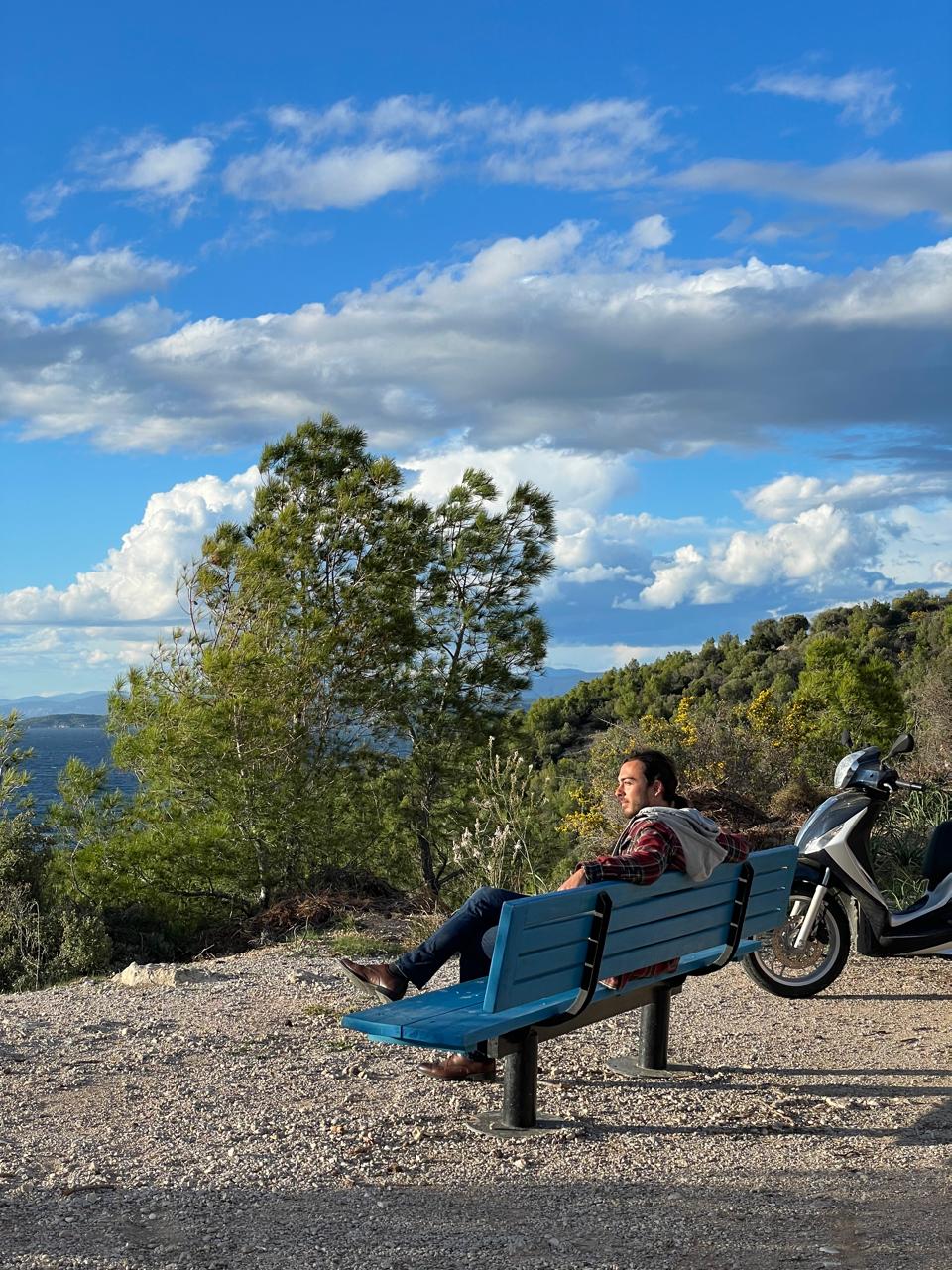
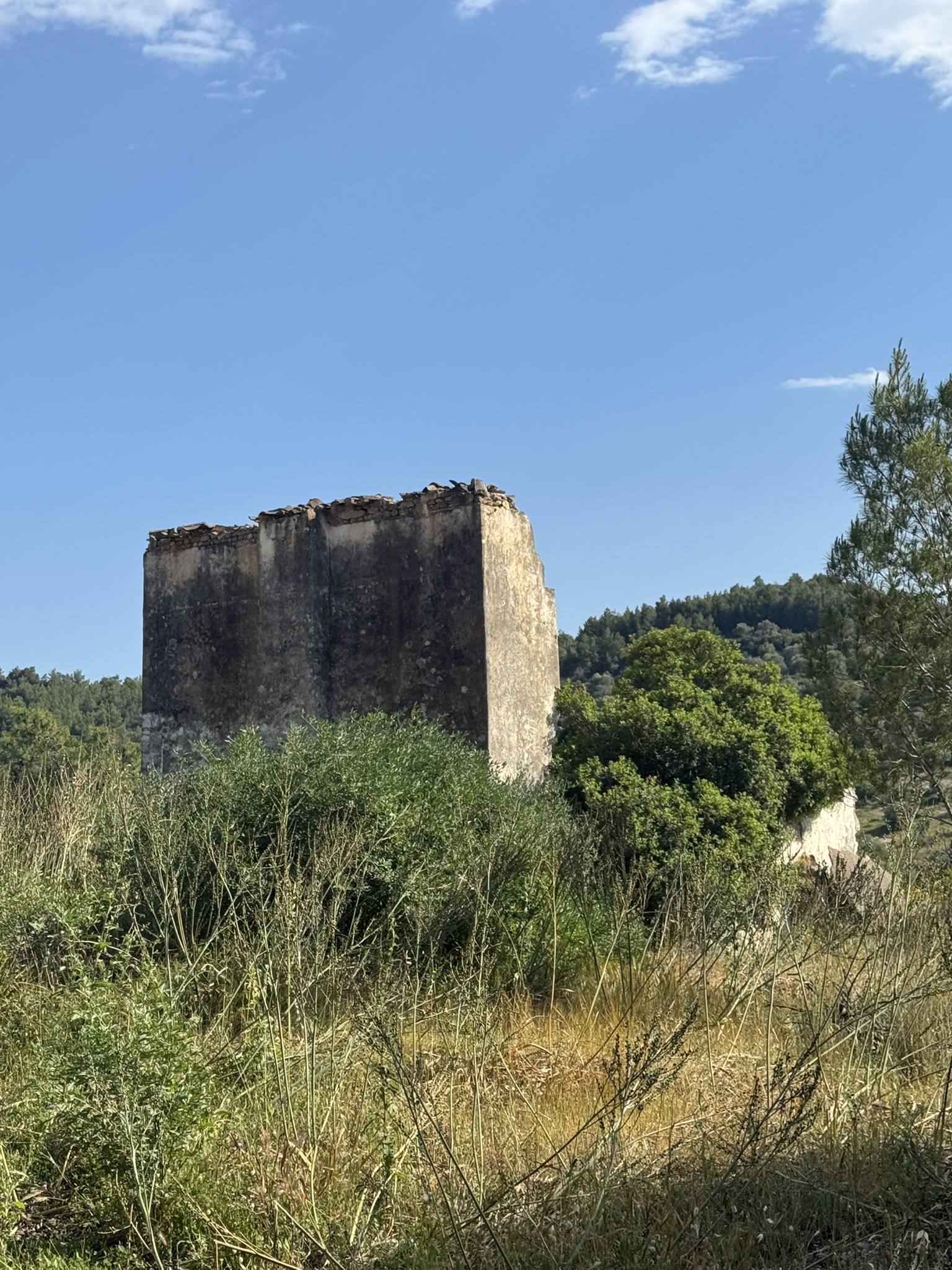
“The cycling tour will take you all the way around Spetses,” Christopher explains. “The island’s circular road is a 26-kilometer cycle that lasts around four hours, with about two hours of actual cycling time. There are no roads internally on the island, making it perfect for hiking enthusiasts. I love showing them the pathways and offering as much information as possible about Spetses’ rich history and natural environment. Having studied ecology, it’s my passion as well. On hikes, we trek up to the hilltop where most trails aren’t suitable for bikes unless you have a high-powered mountain bike. I like to keep outings to around three to four hours, but they’re not strenuous – I give my clients plenty of time to rest.
“On the bike tour, you’ll see mostly breathtaking nature, magnificent sea views, and sprawling landscapes. There’s bits of fascinating cultural history too, regarding land development. Did you know that half the island is owned by a private trust, the Anargyrios and Korgialenios School of Spetses Foundation (AKSS), protecting it from development? You’ll find large expanses of pristine nature, numerous old churches and chapels dotting the hillside, and abandoned properties with intriguing stories attached to them.”
My Franklin and Other Animals
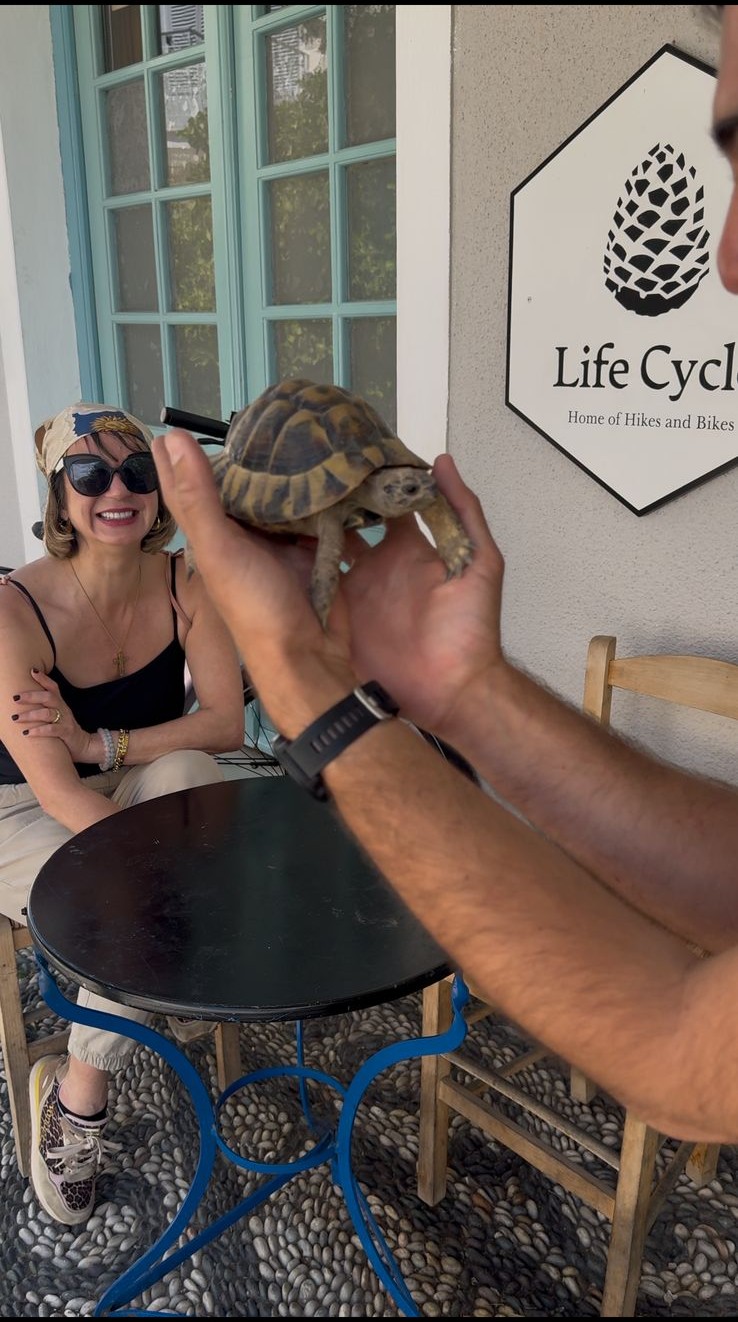
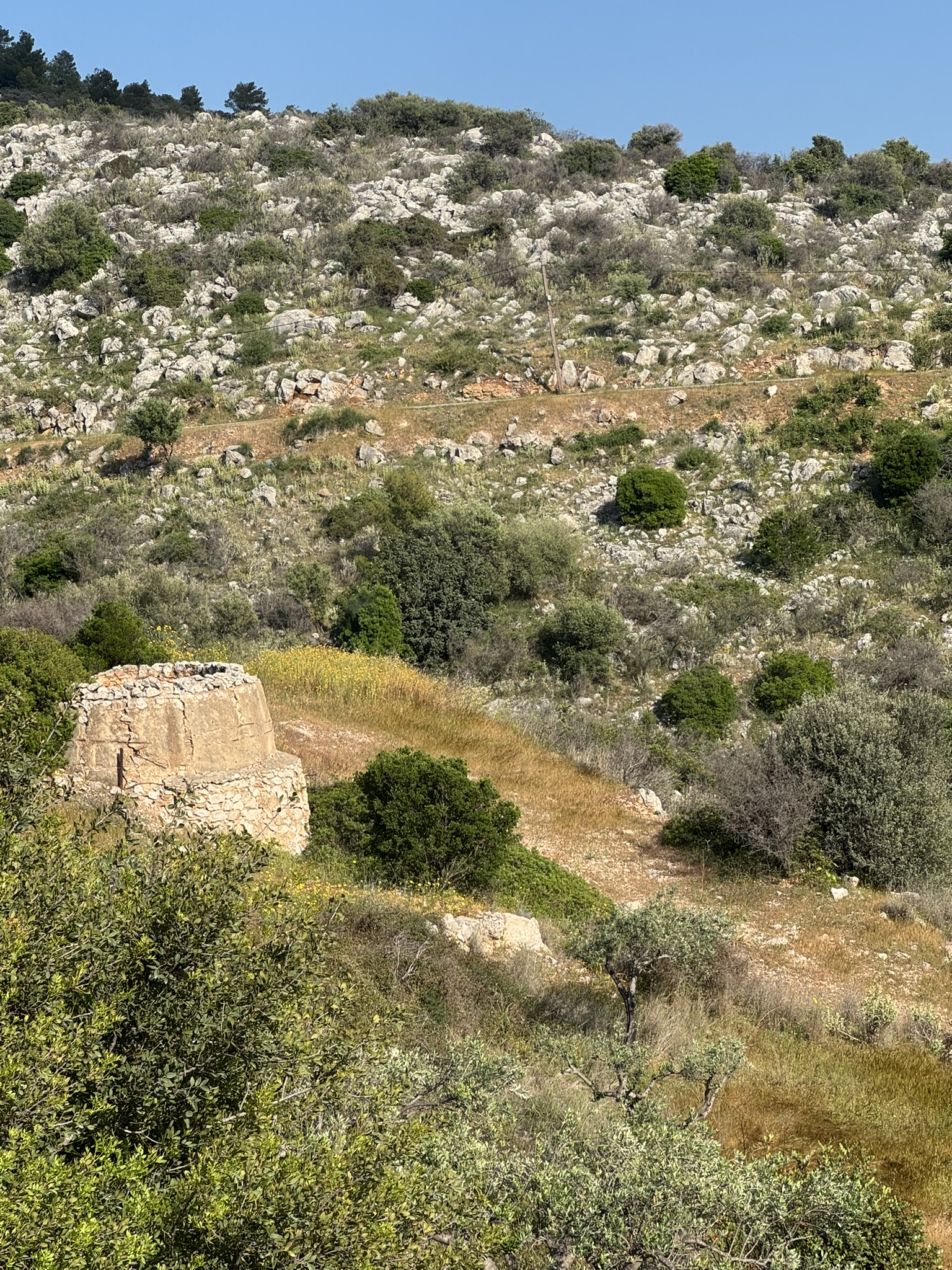
I’ve already met the many pretty cats around Dapia, and it turns out I’m about to meet a whole different variety of creatures too. “Spetses has multifaceted wildlife that I’m passionate about. It’s common to encounter wild tortoises here. I actually have one as a pet – his name is Franklin.” Christopher pauses our chat to find him in the garden and introduces me. Small and surprisingly outgoing for a tortoise, Franklin is utterly charming.
“We also have several resident snake species here,” Christopher continues, making me gulp. “Only a couple are venomous – both adders – but I haven’t seen any on Spetses yet. The most common species is the four-lined snake, which can look intimidating as they grow up to two meters long. But they’re completely harmless with no venom. They’re actually beautiful creatures that I enjoy seeing.”
Suddenly feeling less enthusiastic about my solo biking adventure, I ask for survival tips in case I encounter a black adder. “If you come across a snake, it’ll probably just try to avoid you. They’re secretive creatures that dislike human company. You’d only encounter them while they’re basking in the sun – being cold-blooded reptiles, they love lying on roads because they heat up nicely.” Noticing my unease, he quickly changes the subject. “We also have a species of partridge native to Greece, introduced for hunting, though people don’t hunt them anymore. They usually choose to run rather than fly, being semi-domestic.
Island Botanicals
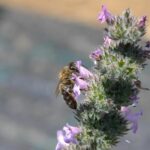
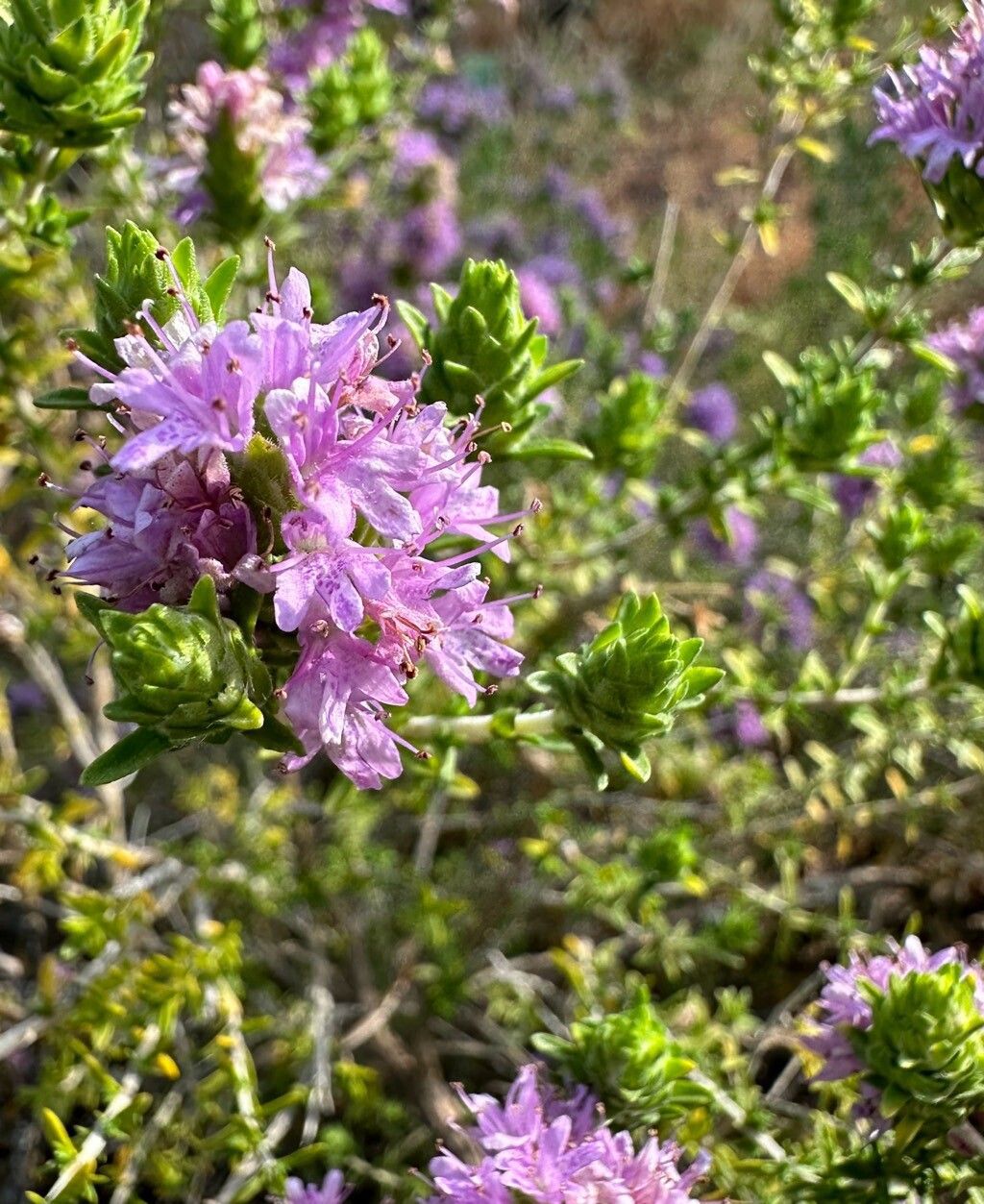
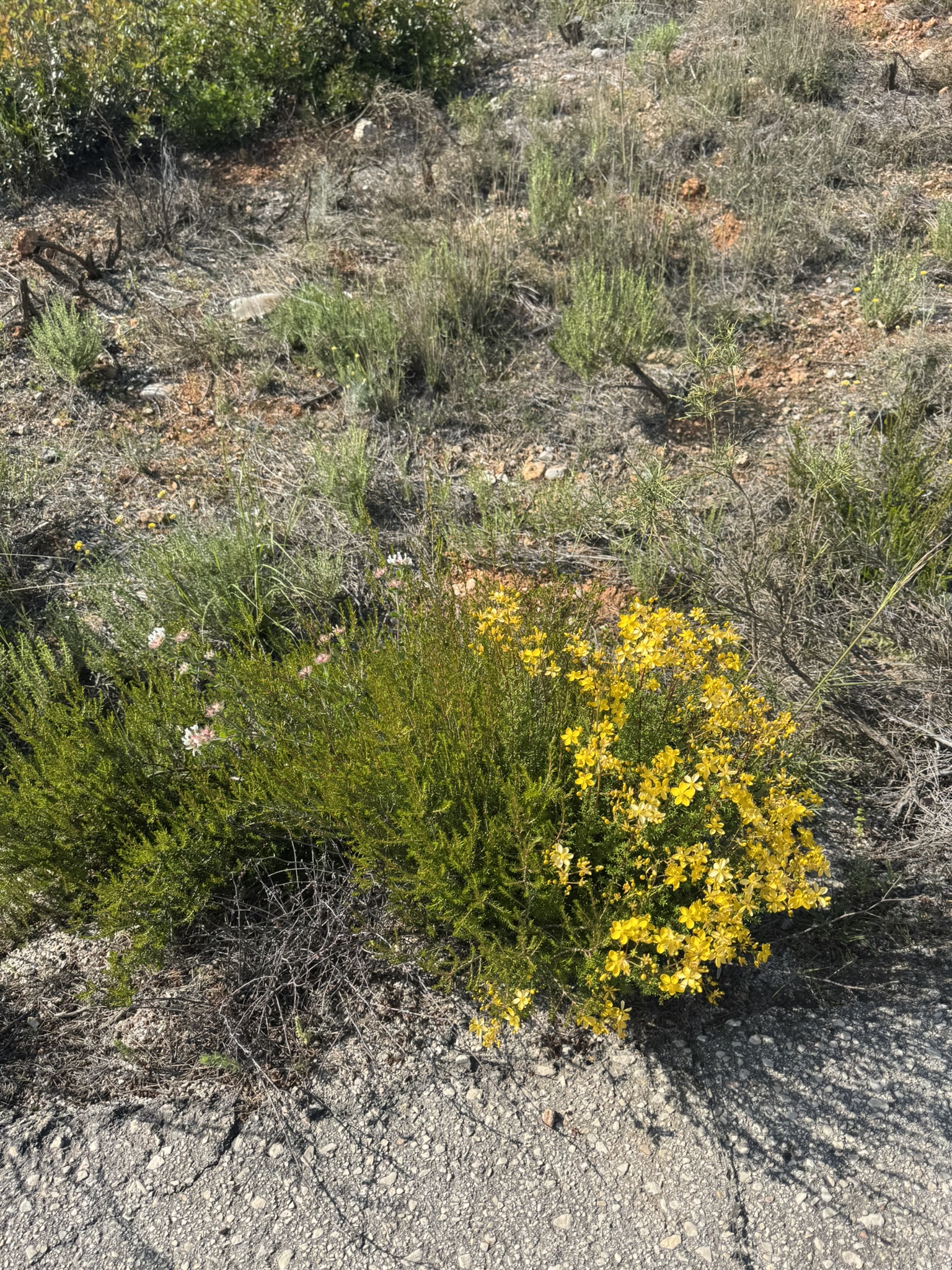
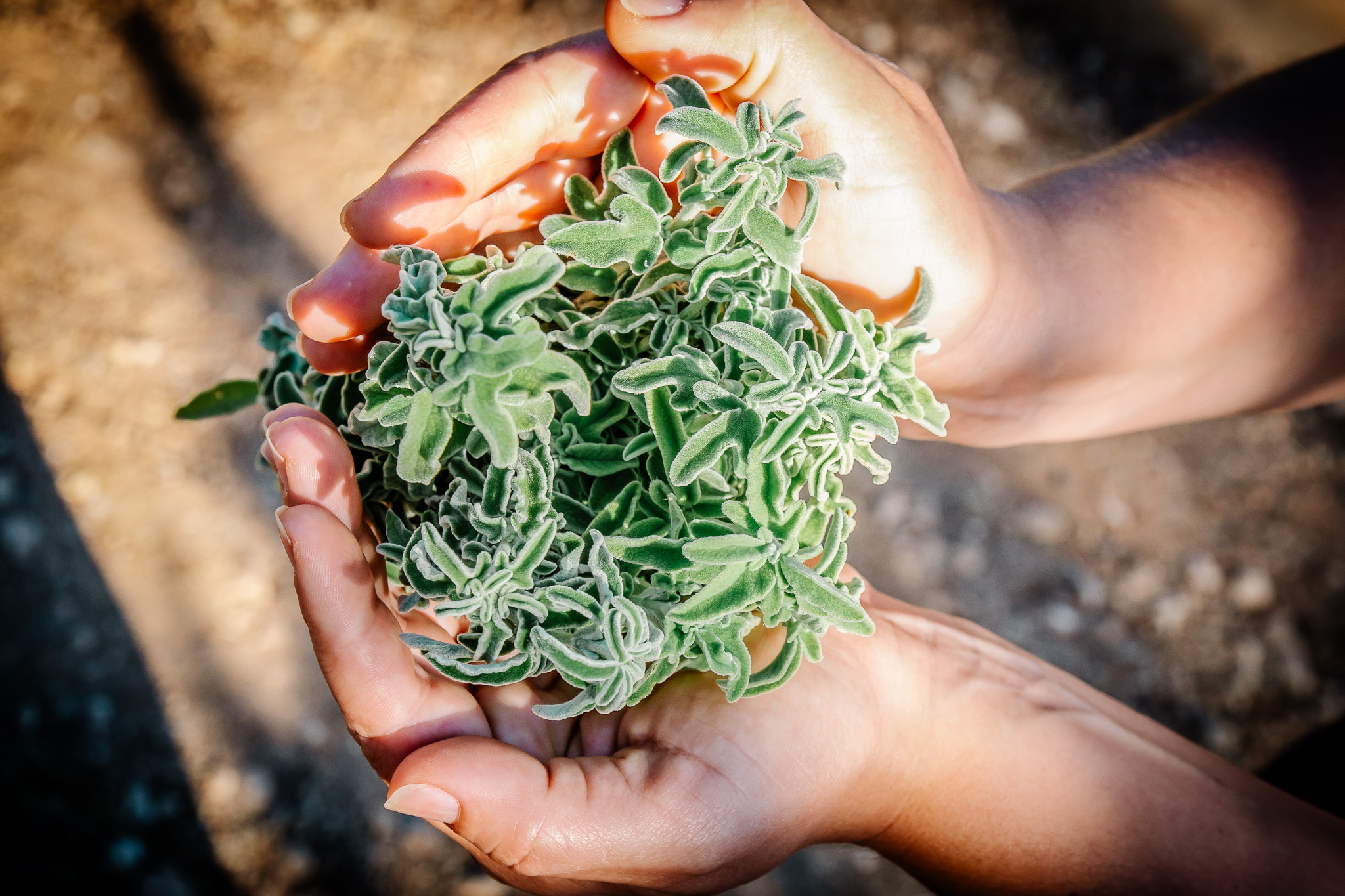
“I’m quite knowledgeable about plants and often forage in winter. I like to point out interesting species, especially herbs and flowers with medicinal properties. The most common here is thyme, ‘thimari’ – in fact, one of the most common surnames on Spetses is Thimaras, meaning ‘thyme collector’ – and a similar-looking variety, called summer savory in English. Then there’s ladania, or rock rose, which you’ll see frequently around the island, especially in spring. It has a beautiful pink flower with significant antioxidant properties. You can dry it and make tea from it.”
“Many visitors like exploring independently, like you’re going to do. Most of my clients are non-Greek-speakers who want to circumnavigate the island and deeply engage with nature. I get lots of couples seeking beautiful beaches, where they can have a romantic picnic. My biggest selling point is that visitors can entrust their day to me. They come to my shop, we find their perfect bike – electric or regular – and I show them my map, explaining the route, what they’ll see, potential hazards to watch for, and my favorite places to visit and swim.”
The Highlights
As I prepare to depart on his newest, most advanced Tenways electric bike (with a carbon belt instead of a chain and 400 watt battery), Christopher offers some excellent guidance, shared with you below.
Start the route by heading to the Poseidonion Grand Hotel near the main port and turning left. The full circuit is 26 kilometers and typically takes about two hours to complete. Christopher prefers going counterclockwise, as the first half of the journey offers most of the accessible beaches. His clients generally spend more time on this first half, then coast through the second portion with fewer stops. Christopher most recommends the following four beach stops.
Vrelos: Perfect First Dip
Veering off the main road, the path to Vrelos is fully paved, making access easy and safe. During summer months (starting from May), a beach bar operates here offering refreshments and snacks. If cycling between mid-October and early May, bring your own provisions for a peaceful beach picnic. Vrelos has fine pebbles with large stones in the crystalline waters. Like many island beaches, pine trees extend to the shoreline, providing welcome shade during hot days.
Treasure of Zogeria
Returning to the main road after Vrelos, you’ll discover this stunning bay. “In my opinion, this is the island’s most beautiful spot,” says Christopher. “It’s a large bay divided into two sections. The first and largest part has several charming beaches along the seafront where you can rest. However, I think the most special area is at the far right – the only sandy beach on Spetses – where there’s also a restaurant.
“The only drawback to Zogeria is that the main road bypasses the bay. There is an access point, but it’s a steep dirt road. Every year we see a few accidents because people underestimate how challenging the descent can be. There’s also a higher risk of flat tires from thorns on this path. To avoid trouble, I recommend parking your bike and walking – it’s only about one kilometer and provides a nice break from cycling to exercise different muscles!”
Continuing along the main road, you’ll face the island’s first significant uphill climb, reaching about 100 meters elevation – hardly noticeable with an electric bike. “However, pay extra attention when descending the other side. This was an accident hotspot last year. It’s not an inherently dangerous stretch, but using your brakes is essential.”
Ag. Paraskevi: Cinematic Views
Halfway down this hill, you’ll notice the forest on your right giving way to reveal spectacular westward views. “This section can be dangerous if you’re distracted,” Christopher warns. “Picture a cyclist speeding downhill who turns to admire the beach and loses control. Simply use your brakes properly – that’s all you need to do.”
Further along, you’ll reach a magnificent W-shaped bay with stunning vistas, eventually arriving at Aghia Paraskevi Beach, which is easily accessible and exceptionally beautiful. Many visitors to Spetses consider this their favorite beach. “I appreciate that the beach bar occupies only half the beach, leaving the other half completely natural. They don’t play music here, so it’s wonderfully peaceful. The structure itself is charming – resembling a small square tiki bar.”
Behind the beach stands the beautiful Church of Aghia Paraskevi. “In late July, on the 26th, a traditional celebration takes place here, often featuring a live local orchestra, which is wonderful. Street vendors sell delicious food alongside stalls offering trinkets, creating a fantastic festive atmosphere,” Christopher shares.
Ag. Anargyri & Bekiaris Cave
Next, you’ll tackle the island’s second major uphill section, followed by a descent, and then you’ll encounter Aghi Anargiri Beach. “This beach marks the midpoint of your circuit, making it an ideal rest stop. It’s typically the most popular and largest beach, though peaceful during the off-season.
While at Aghi Anargiri, consider visiting Bekiris Cave, where the sea extends inside to reveal a beautiful underground beach. To reach the cave, leave your bicycle by the restaurant, walk across the beach, and behind the water sports hut you’ll find a track through the forest. It’s a 10-minute walk before the path ends at rocks by the water’s edge.
“From there, you have two options,” Christopher explains. “You can either jump into the sea and swim into the cave, which is tremendous fun, or use the second entrance that doesn’t require swimming. For this approach, locate the rock wall at whose base is an entrance. Sit down at this point, and you’ll notice steps leading into the opening. Carefully lower yourself down, and once inside, you’ll find a walkway constructed in the 1950s. It’s above sea level, so you won’t even need to remove your shoes, and it leads all the way to the back of the cave.
“Inside, there’s a sandy beach forming a semicircle split by an interesting rock formation. At the top of this formation, you’ll notice a naturally occurring bowl. Winter rains filter down from the hillside, collecting here, and if fresh, the water is drinkable. I tell my clients this is actually the Fountain of Youth, and that I’m secretly 100 years old!”
Moving on from Aghi Anargiri, you’ll face the third and final significant uphill climb. From this point onward, you’ll maintain a relatively consistent elevation of about 100 meters.
Read more about Spetses’ beaches here.
A Verdant Return
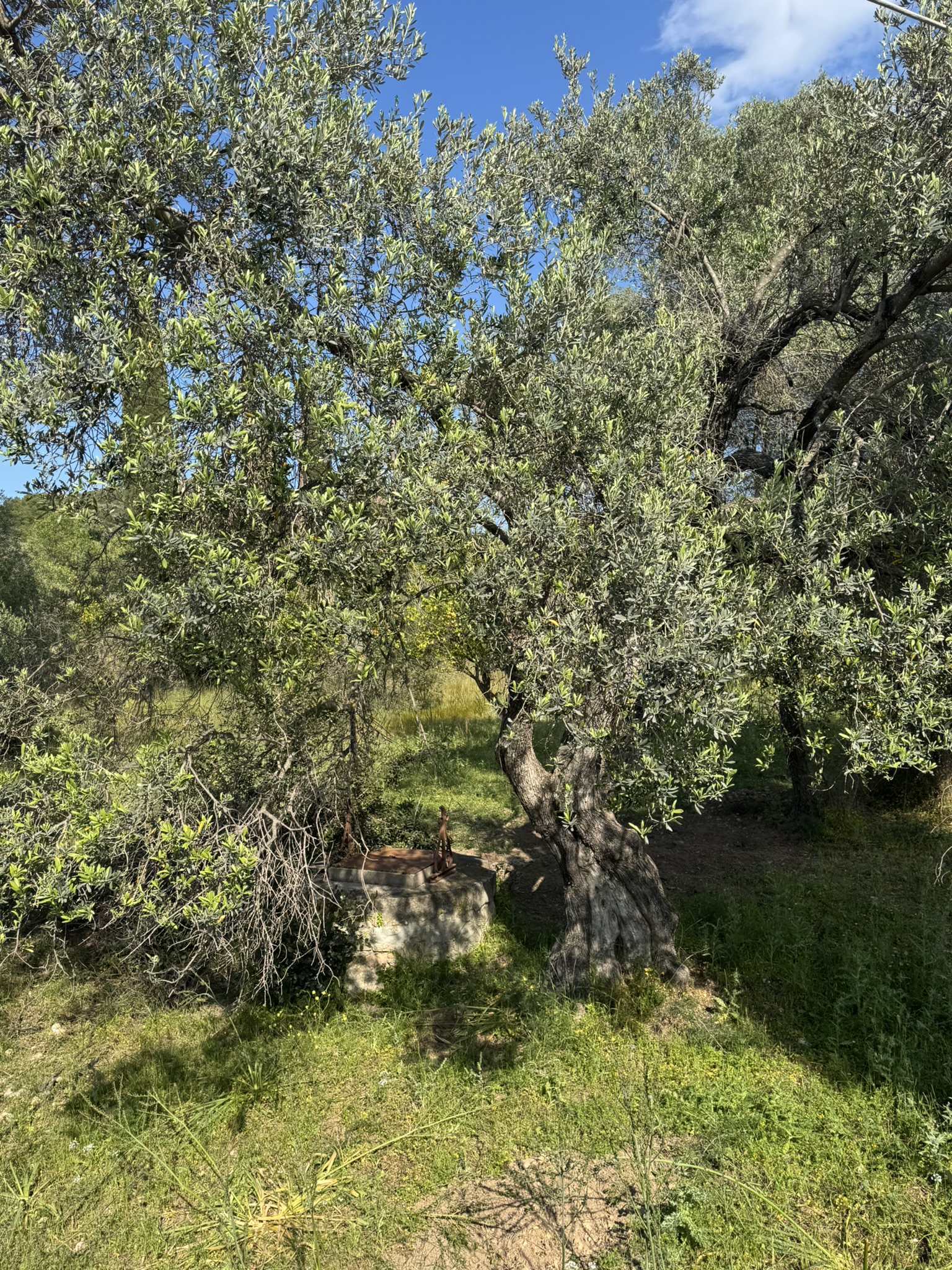
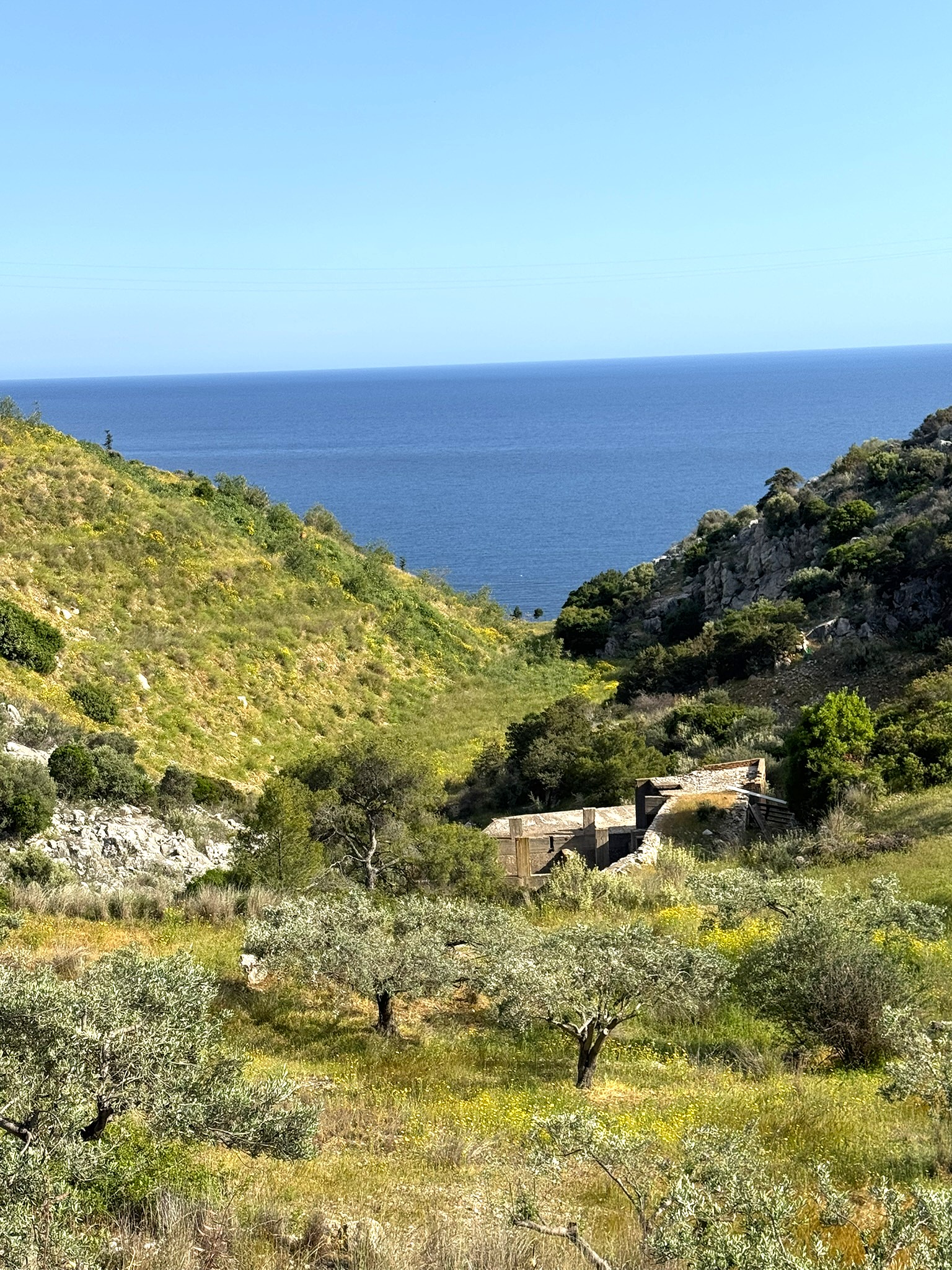
The second half of the journey offers fewer easily accessible beaches, but compensates with fantastic views of the southeast coastline. Christopher notes, “Just after Aghi Anargiri, you’ll notice the pine trees are shorter than those on the northwestern side. This is because of a wildfire in summer 2018, so the trees have only grown to about a meter height. It presents a different aspect of Spetses’ beauty.
“From here onward, you’ll begin to see numerous opulent villas, some with their own helicopter pads. Off the coastline, you’ll spot a private island – Spetsopoula. It belongs to the Stavros Niarchos Foundation and is completely inaccessible. They’ve primarily developed the north-facing side, with properties appearing every 100 meters or so.”
My Experience:
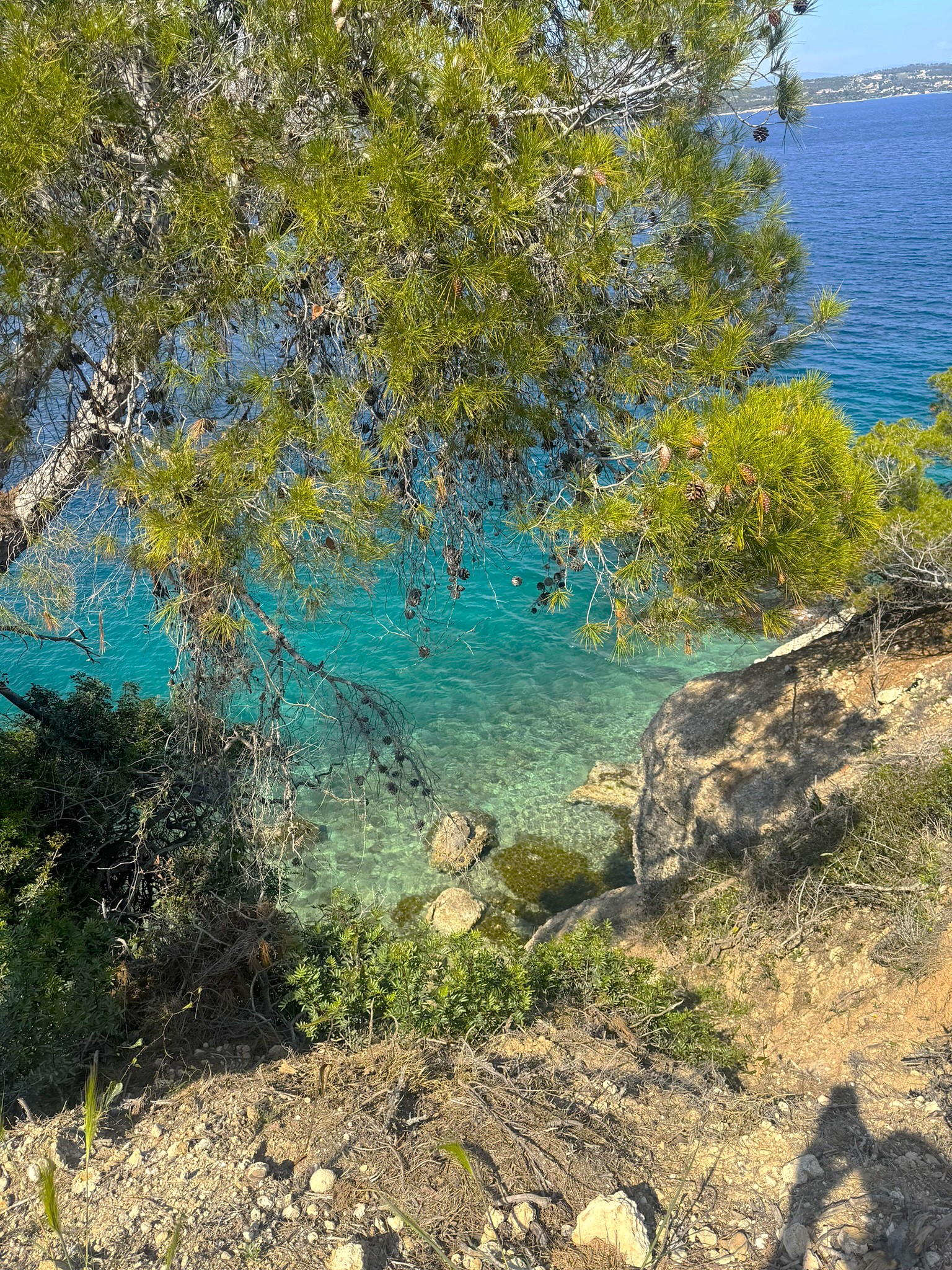
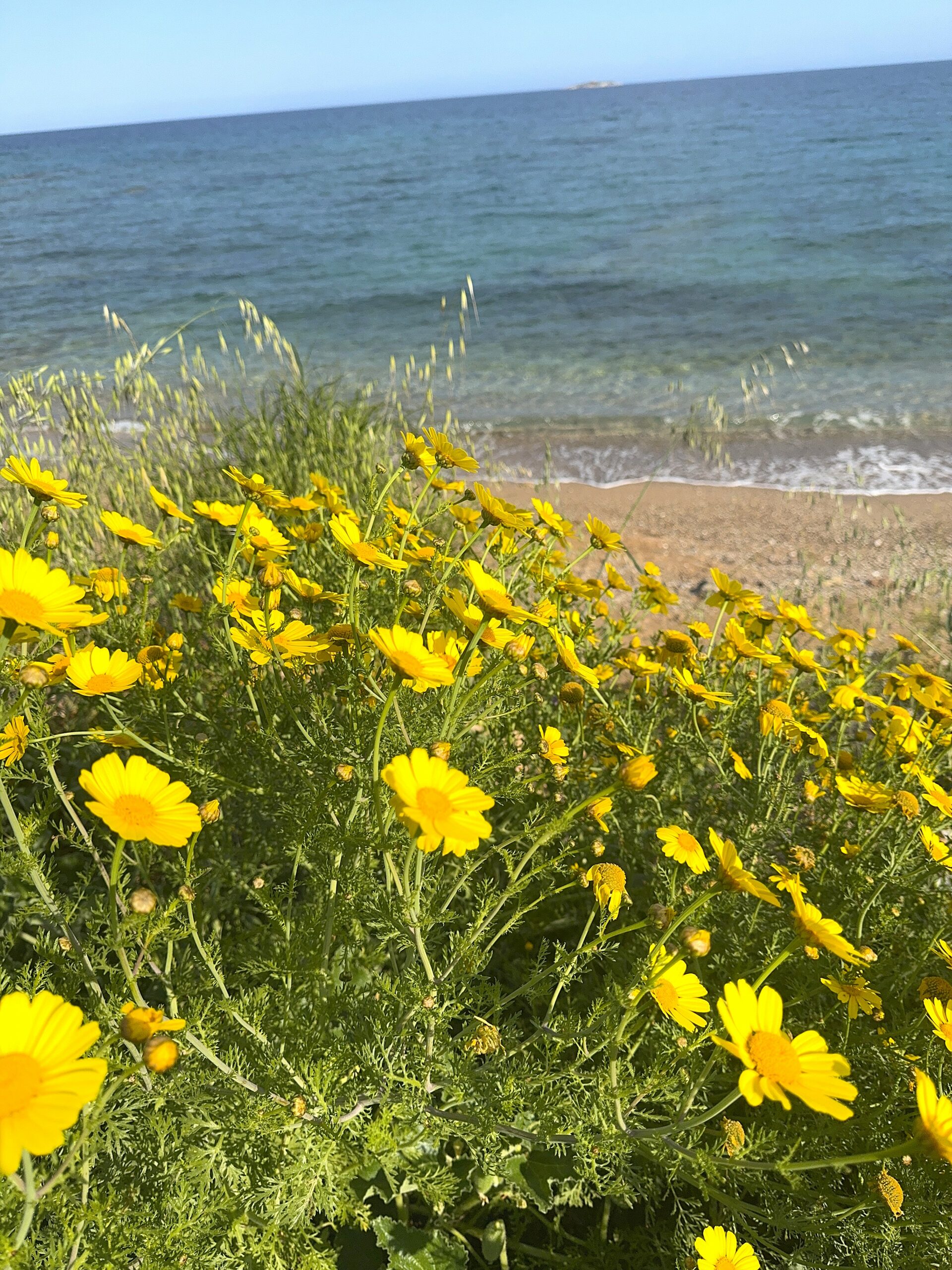
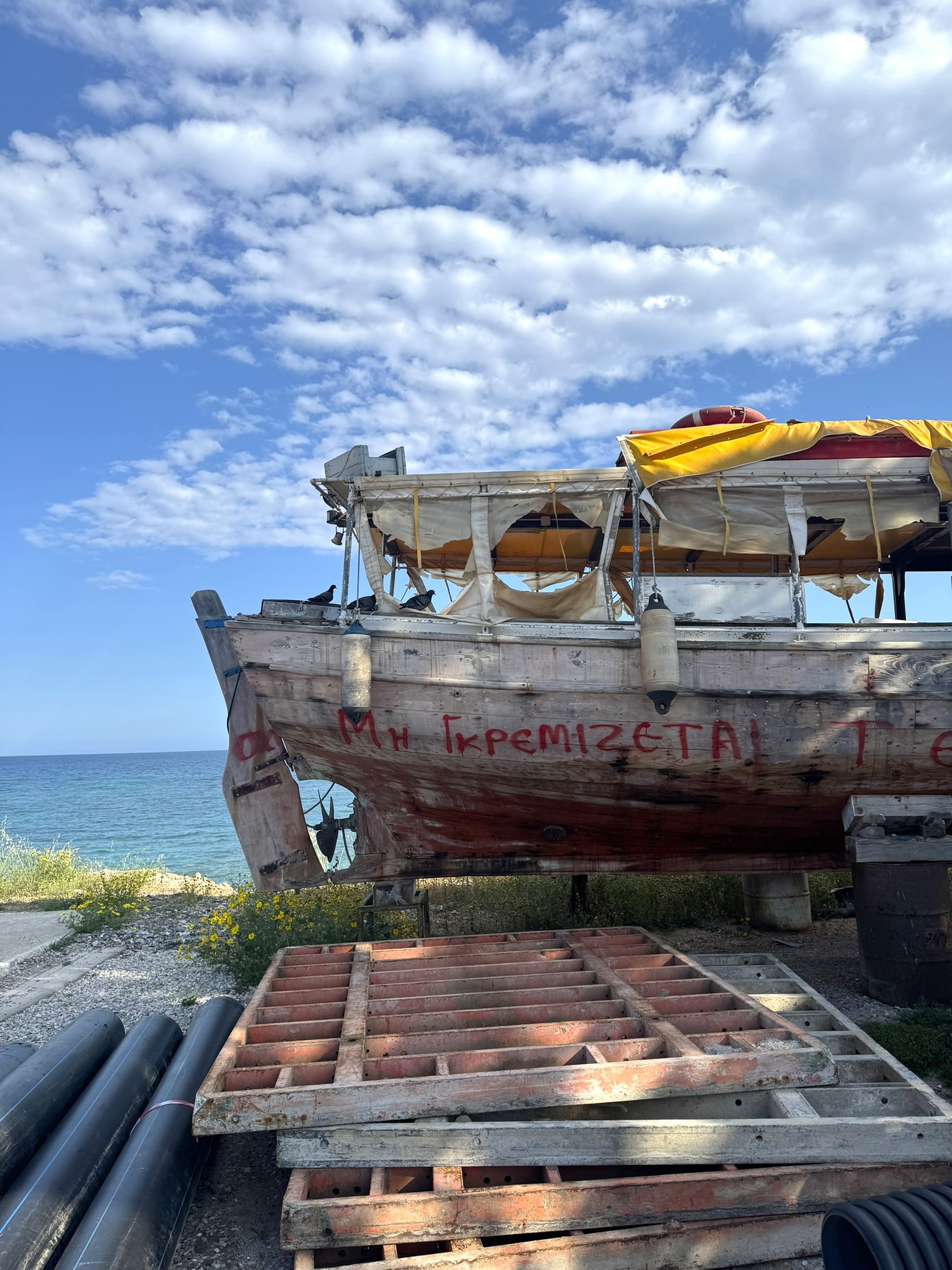
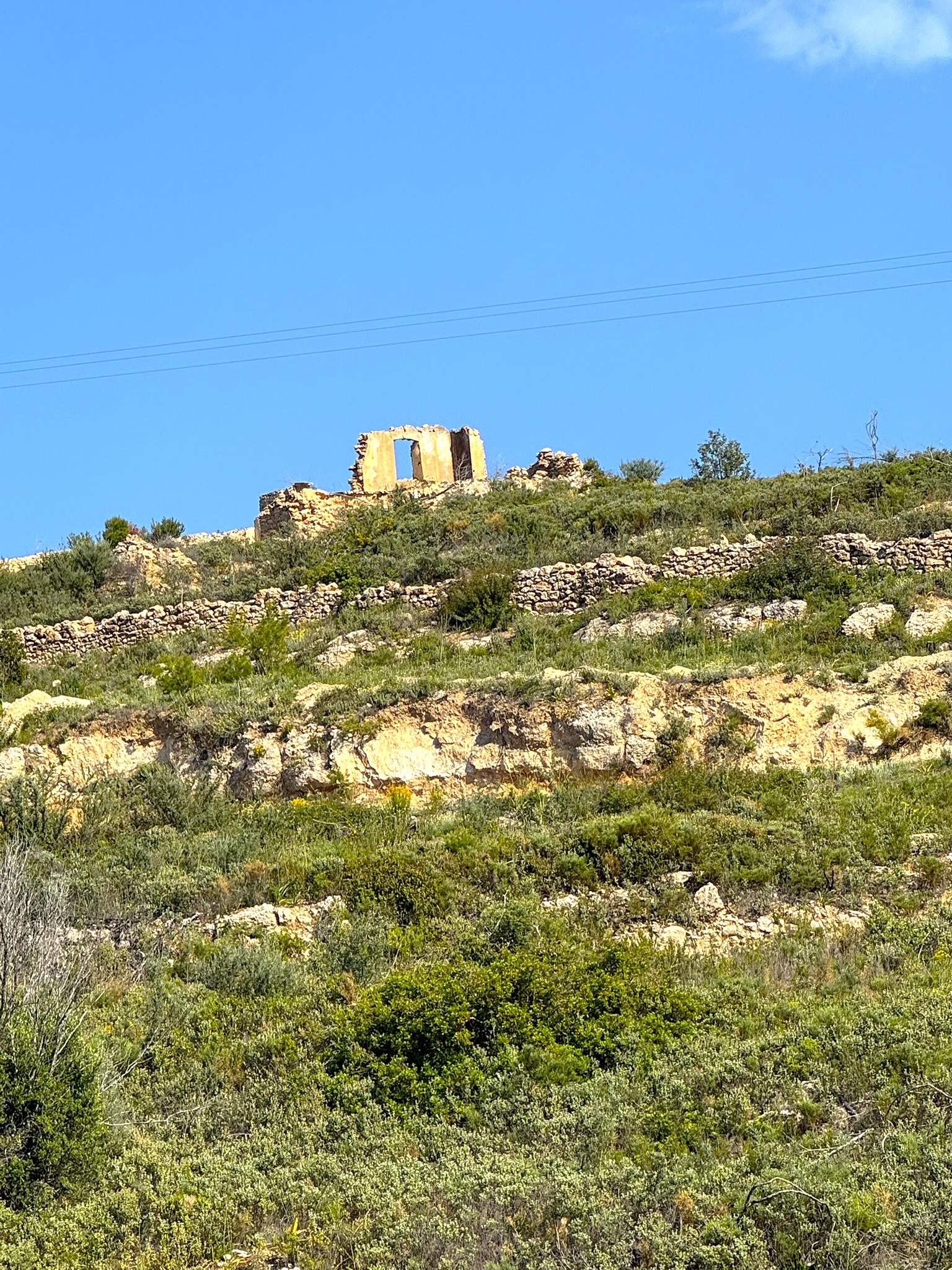
Though naturally adventurous, active, and nature-loving, I can sometimes work myself into a slow-burning, paralyzing anxiety when preparing to venture into unfamiliar territory alone. The thought of encountering striped snakes (and black adders!), tumbling down steep dirt roads, or getting lost (as someone with dyscalculia, this can happen even in small restaurants) didn’t inspire great confidence. Yet, Christopher’s precise, enthusiastic and reassuring guidance made the experience irresistible. Besides, I had a massage at the Idolo Spa to look forward to right after – what could be more ideal?
My first stop was Vrelos beach, where I enjoyed an invigorating swim (water temperature around 18°C), in crystal-clear waters. Following the main road with surprising ease, I feasted my senses on fresh sea air and dazzling views of glittering azure waters at every turn. The euphoric aroma of pine (the tree that gave Spetses its earlier name, Pitiousa, and remains the island’s prominent symbol along with its cone – interestingly, also a universal spiritual symbol of the third eye) emanated from the lush forests covering the island, while wildflowers dotted the landscape with white, pink, red, and yellow blooms.
The sun was perfectly warm without summer’s overwhelming heat (if cycling during hotter months, wear a hat and set out in early morning or late afternoon), the breeze fresh yet gentle, and the sense of freedom – the privilege of solitude away from cars, buildings, noise, and crowds – exhilarating. With limited time, I stopped frequently, often awe-struck, to snap photos. I enjoyed one more dip at the easily accessible and beautiful Aghia Paraskevi beach, with its curiously forward-bending trees. Even in late April, it drew quite a crowd, suggesting summer would bring throngs of visitors. Unfortunately, the charming Church of Aghia Paraskevi, with its white façade, small courtyard, and climbing bougainvillea, was closed, so I couldn’t enter to light a candle as planned.
Without question, I intend to repeat this experience soon; as I returned to Spetses town, however picturesque and interesting it is, I already yearned to go for a second cycle around. Next time, I’ll allocate at least five hours, bring friends along (solitude is wonderful, but so is good company, especially when planning cave explorations, frosty beers, and fresh fish), and truly savor every moment of this memorable experience in an entirely different season.
Many Thanks to Christopher Kontaratos and Life Cycle, Home of Bikes and Hikes.



